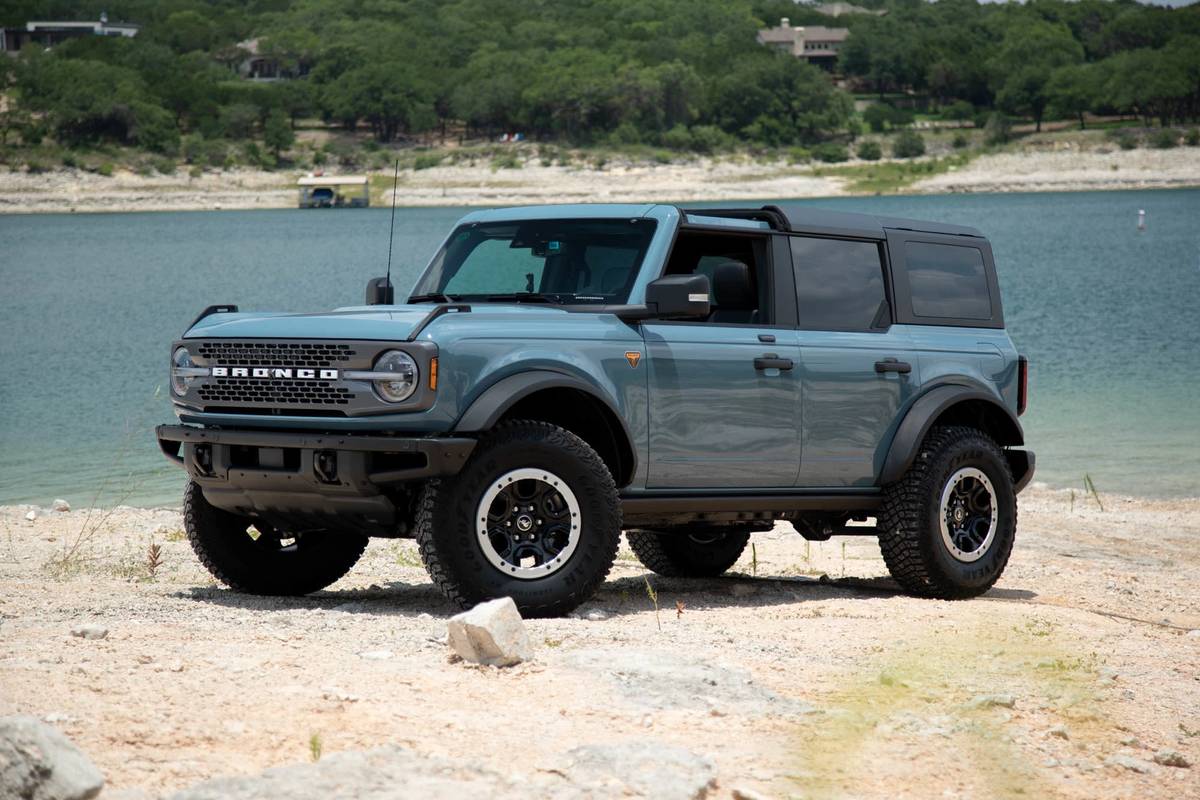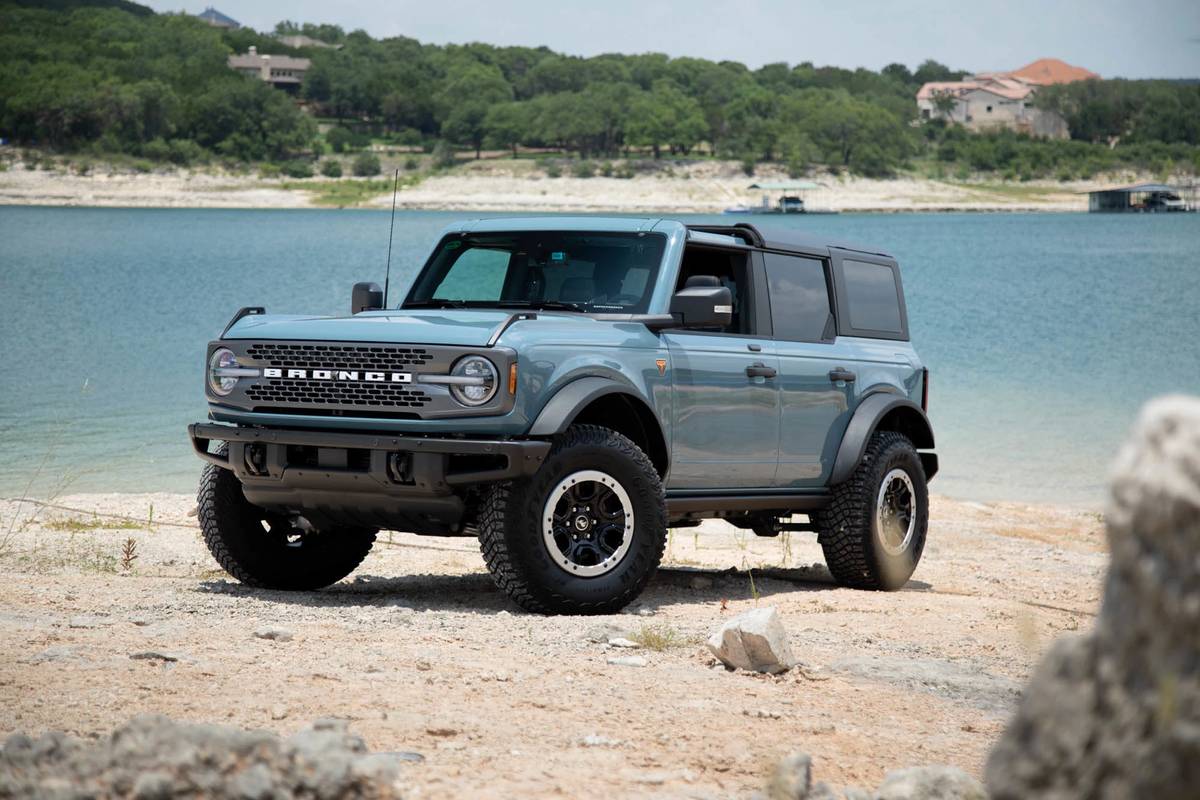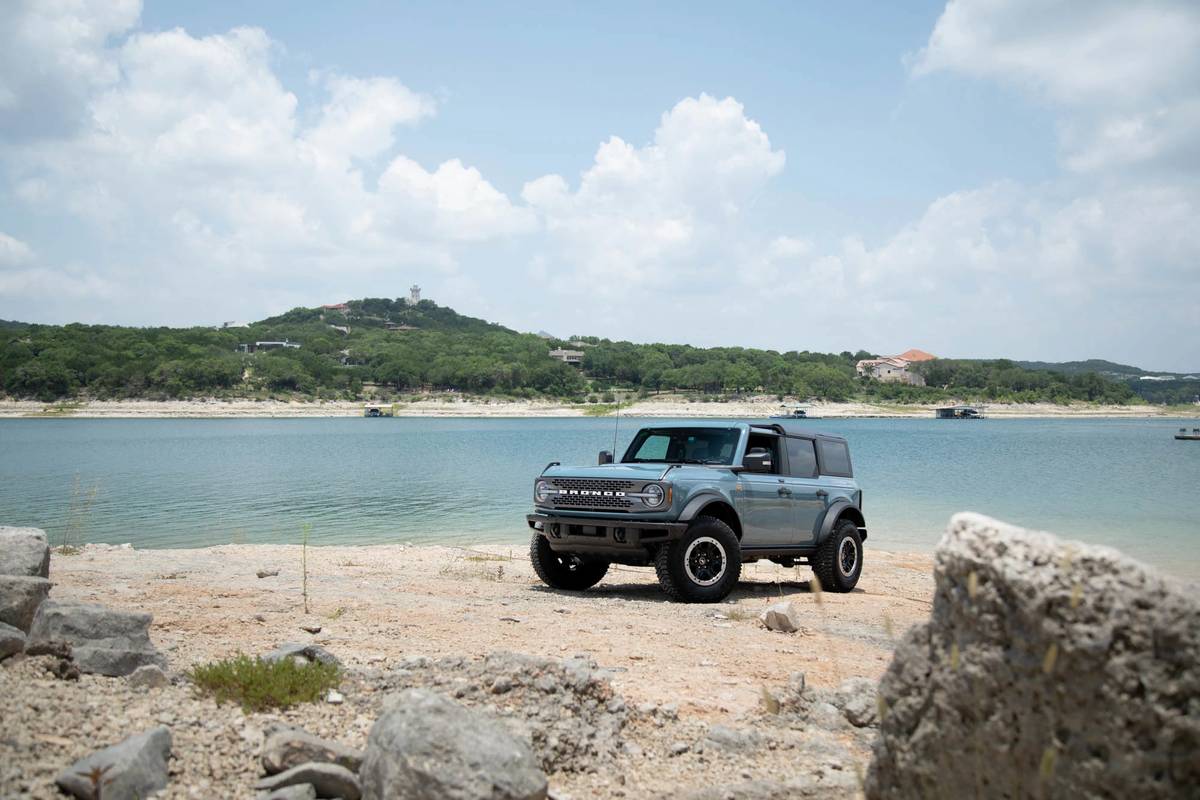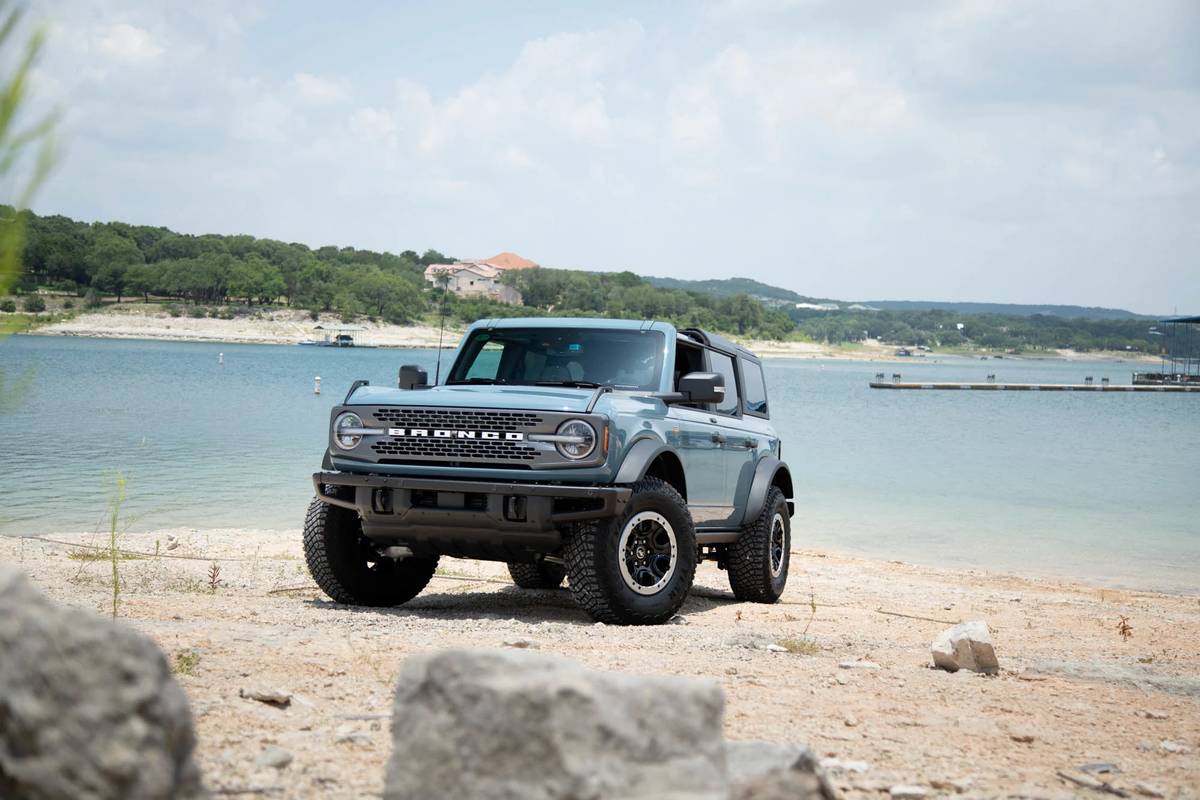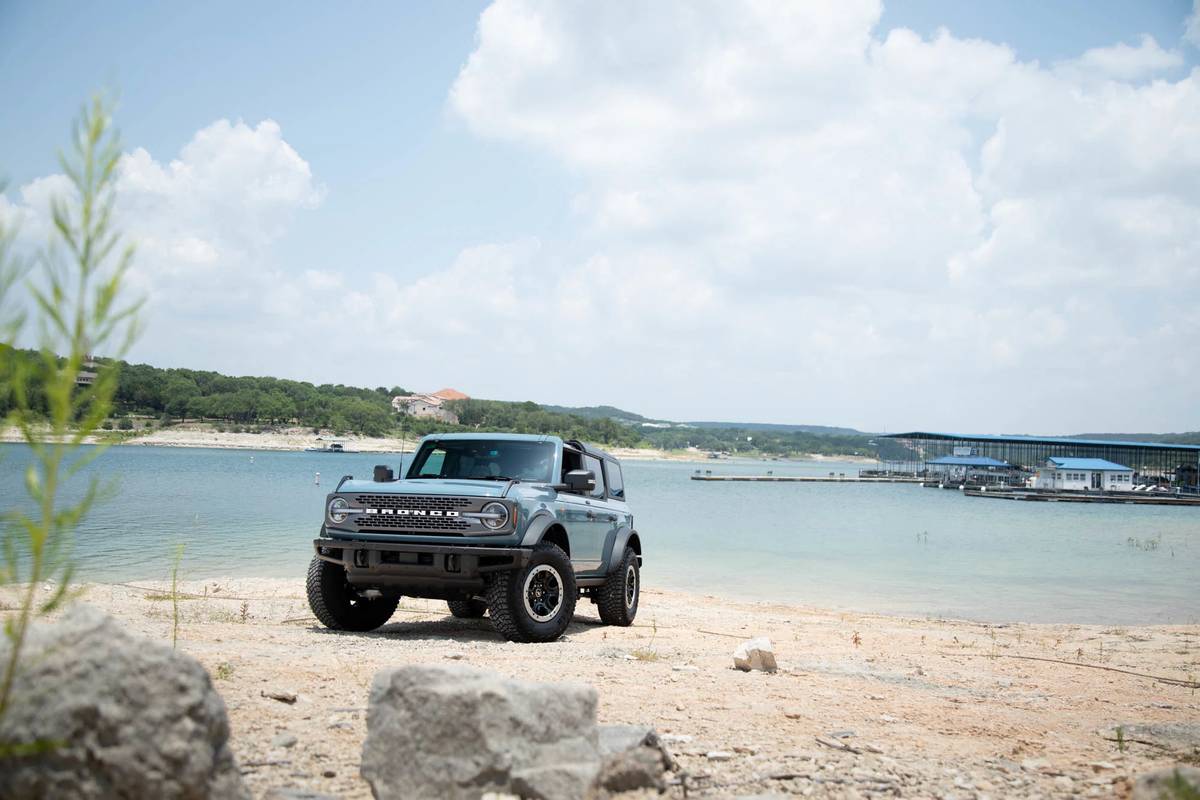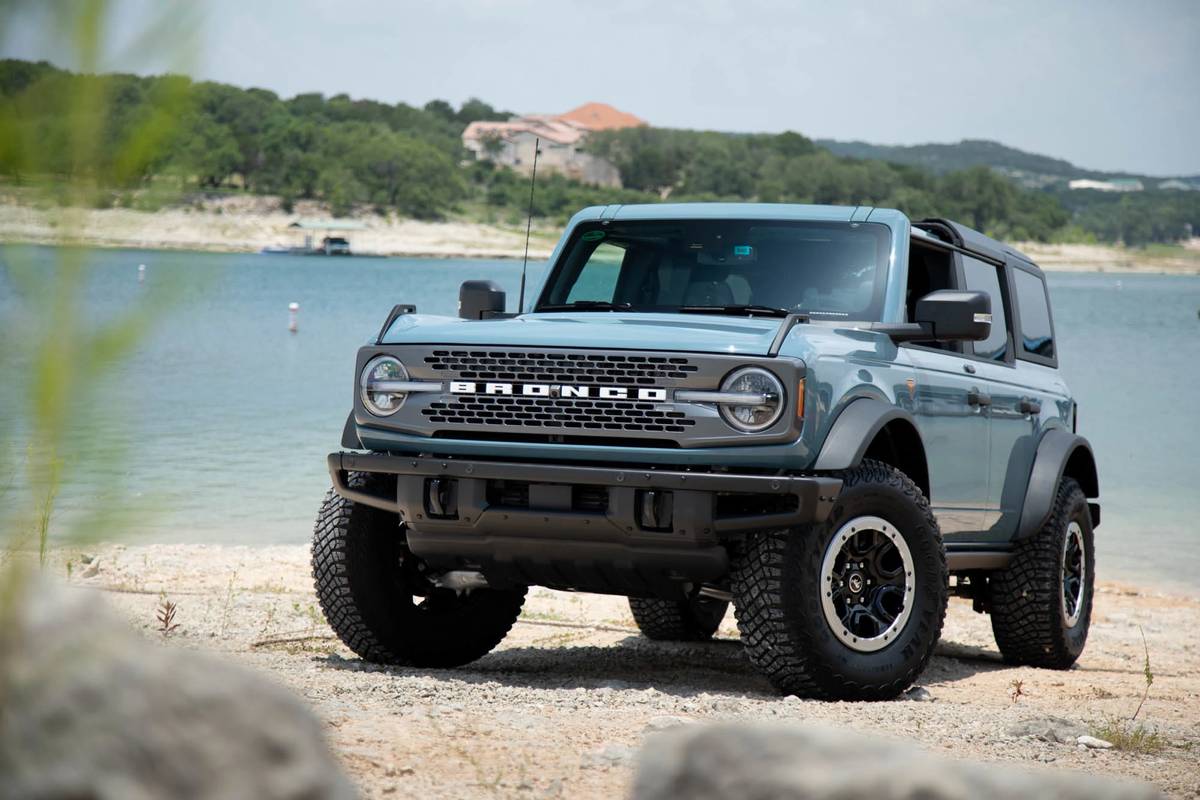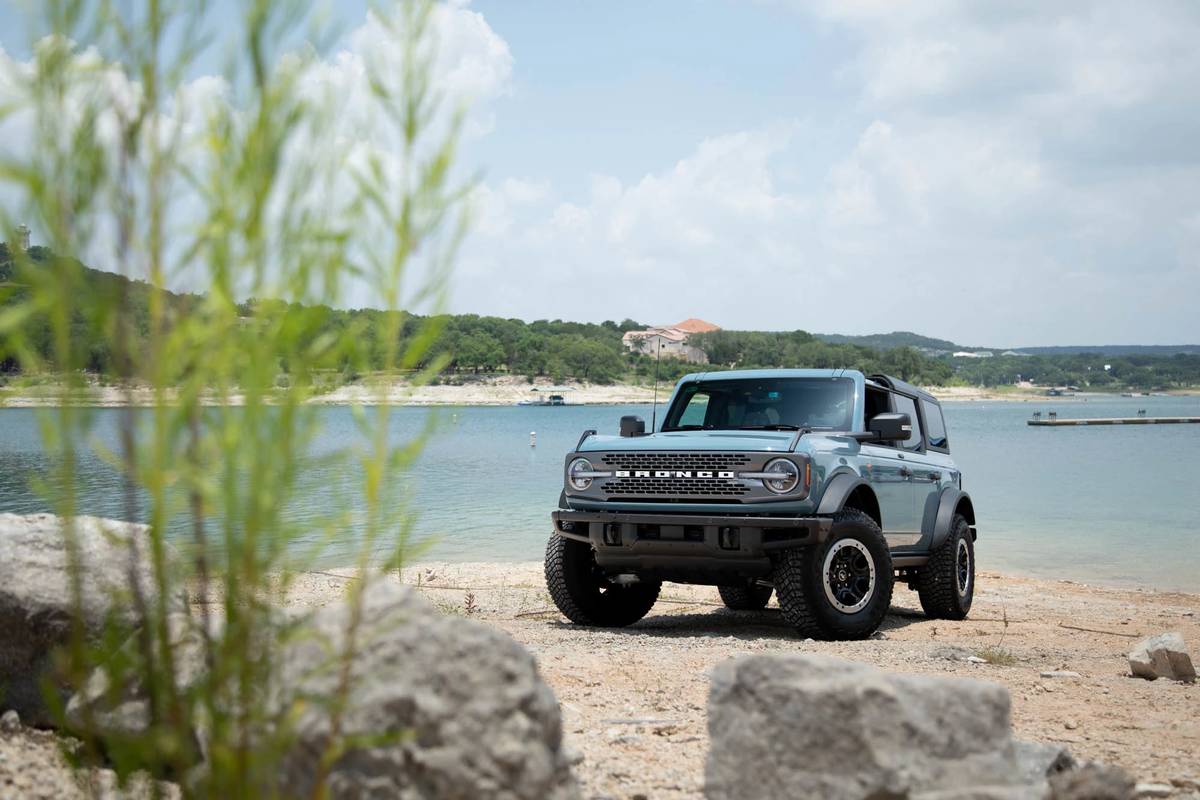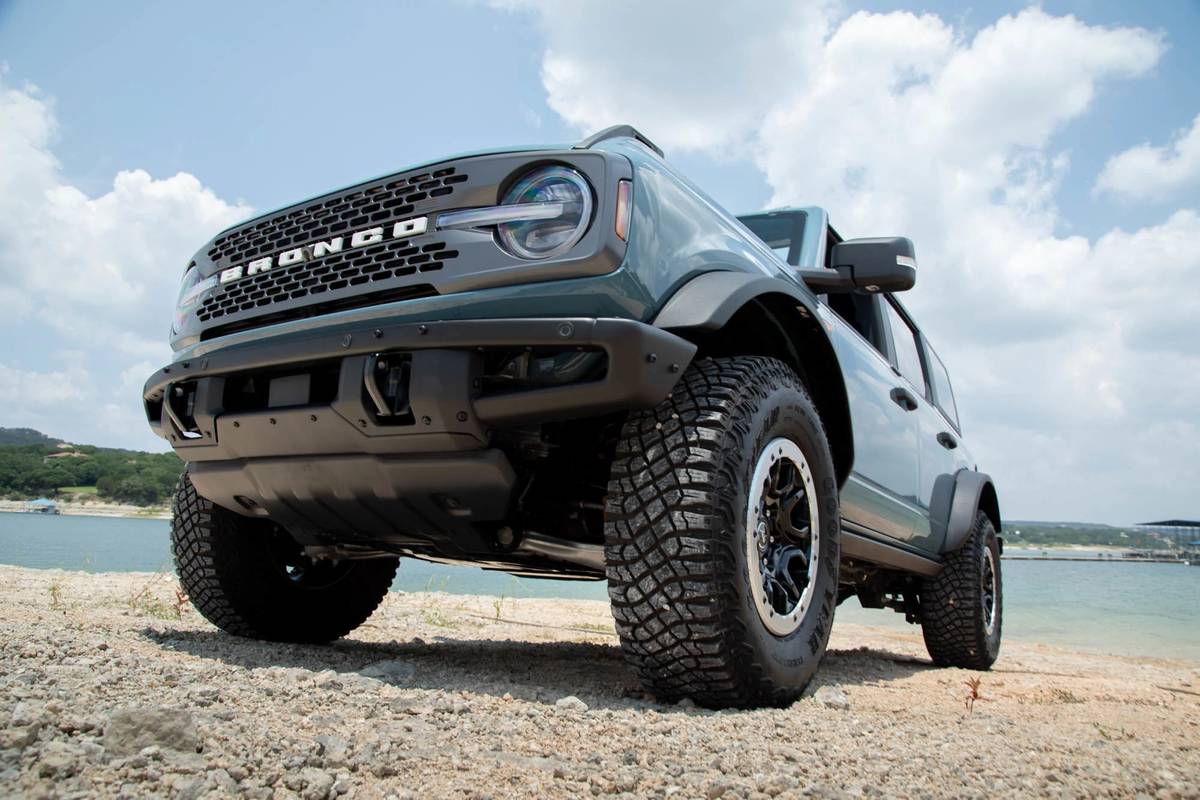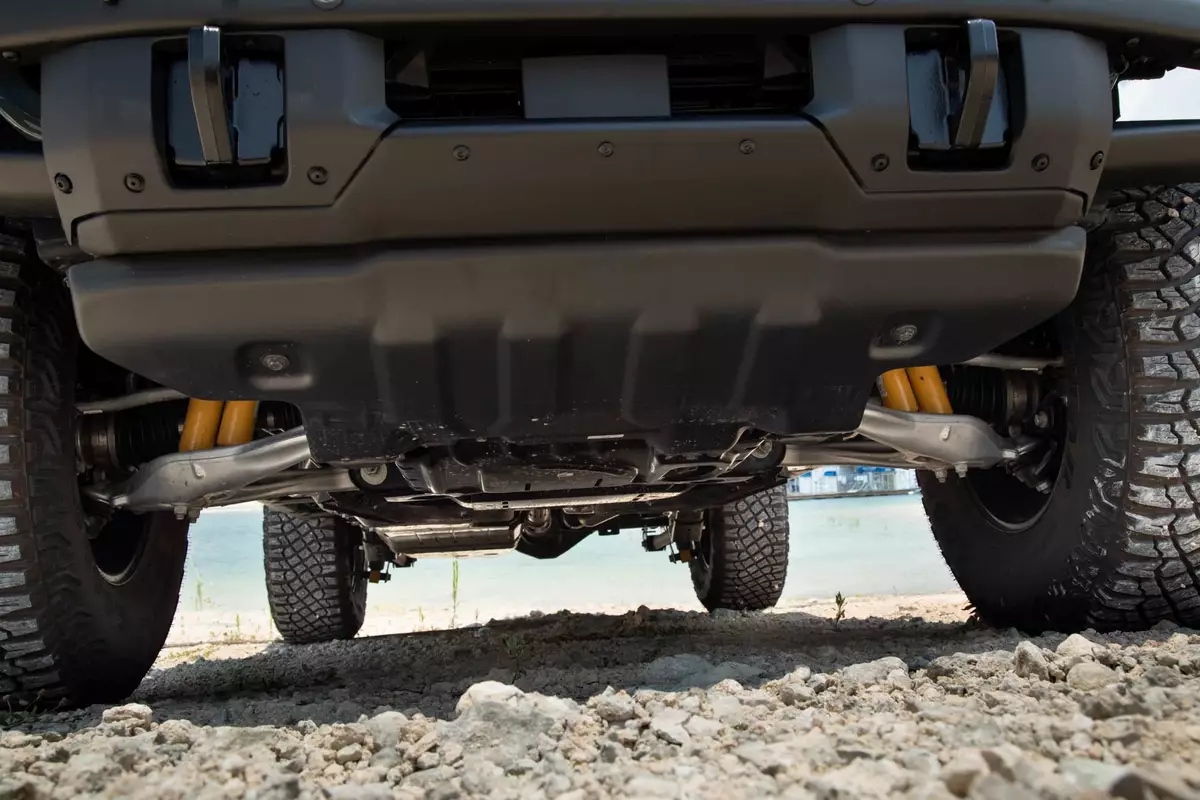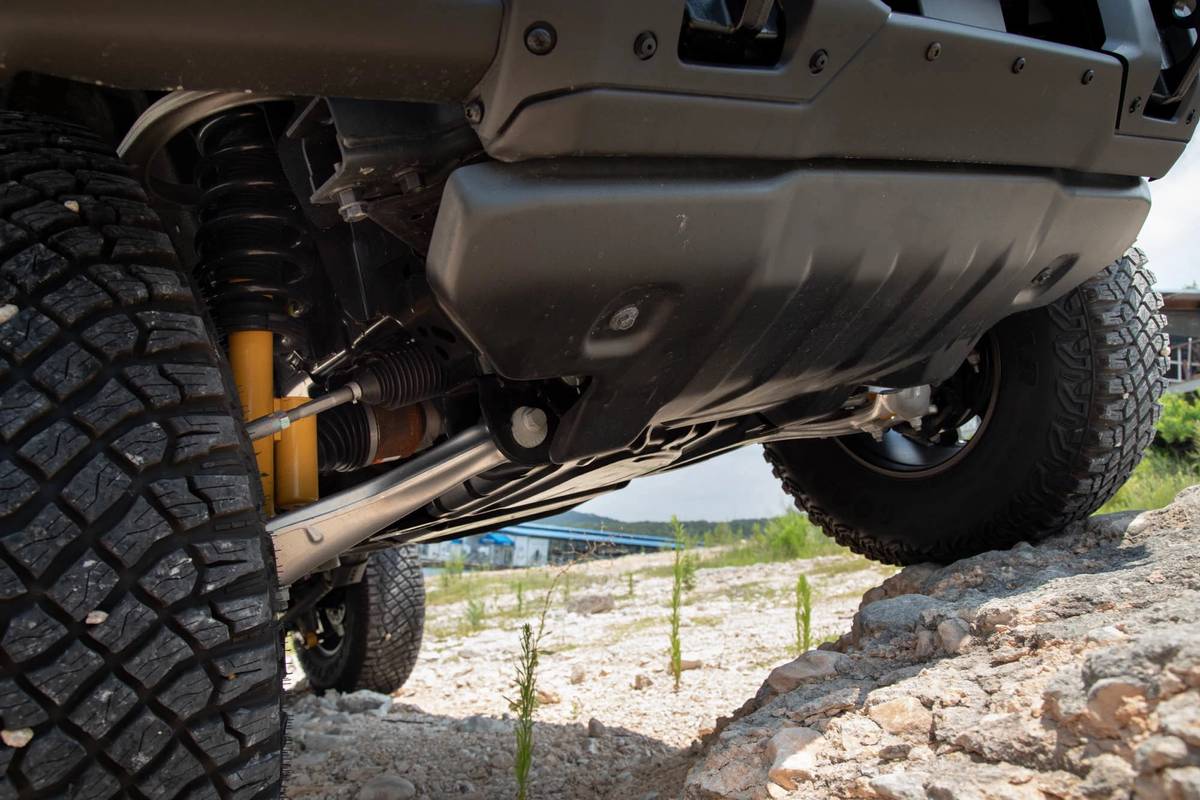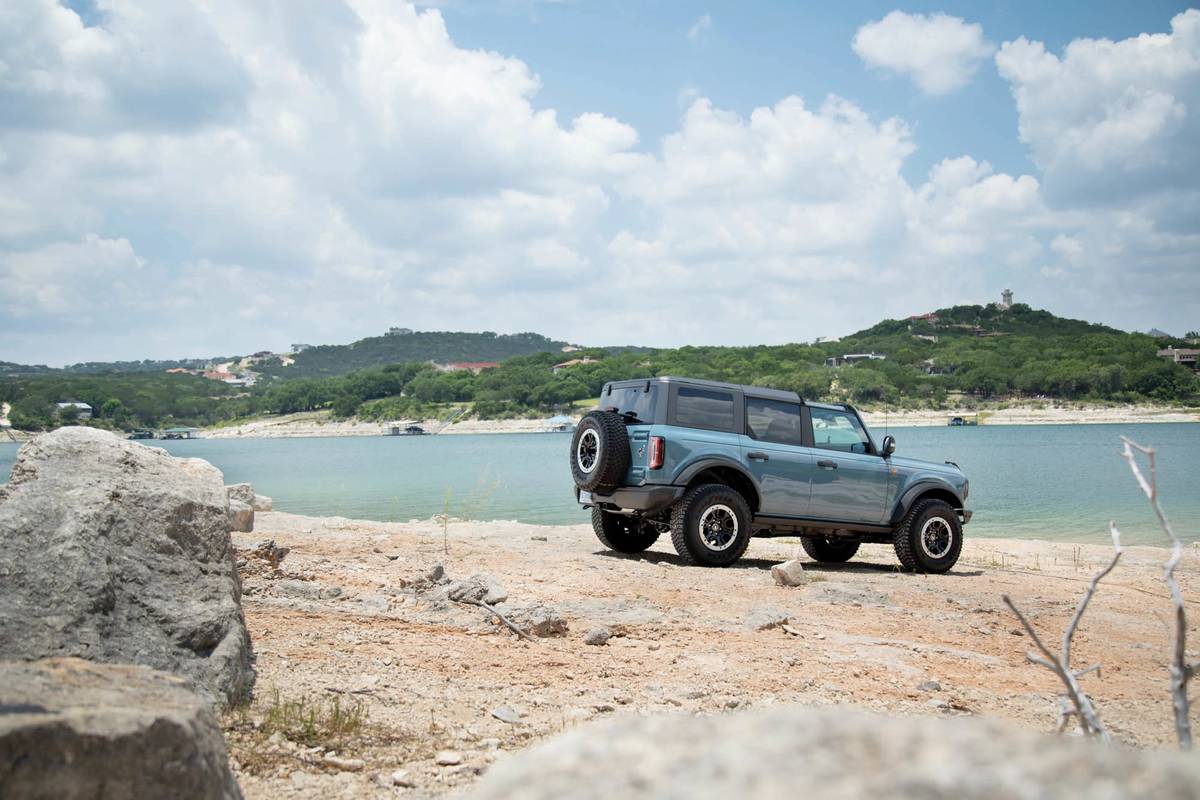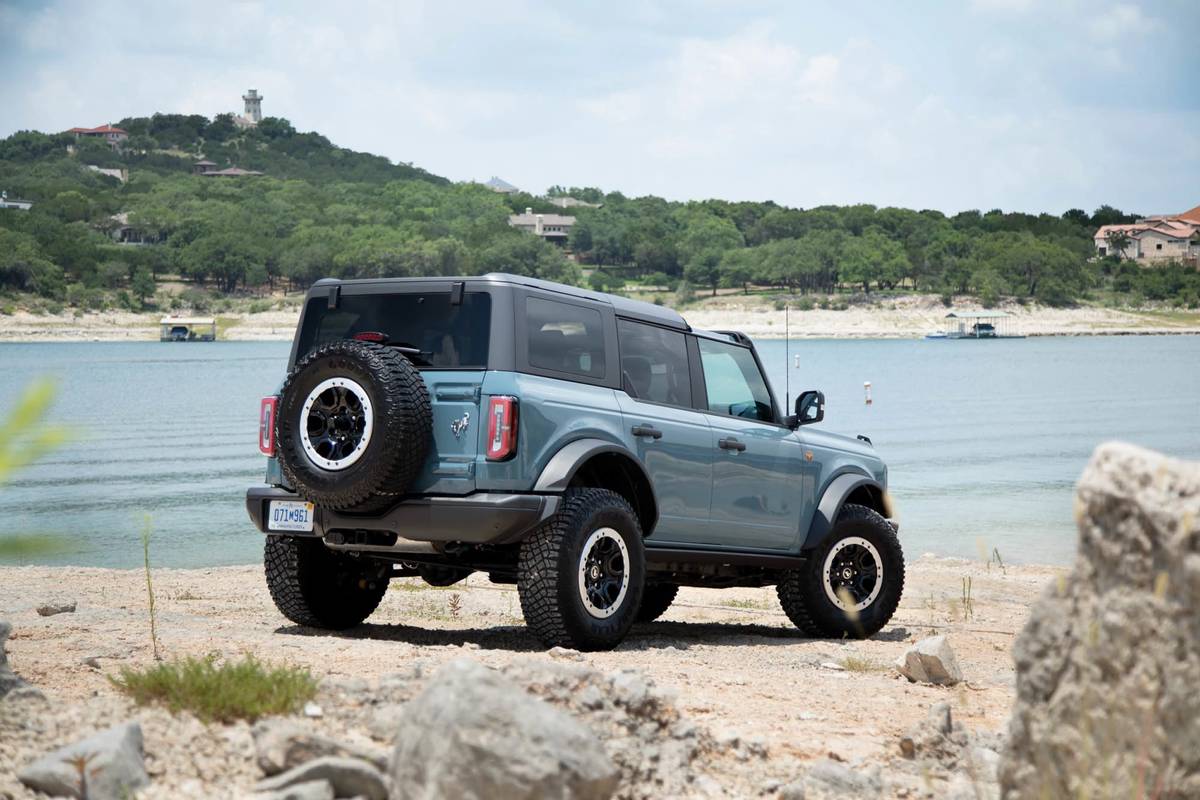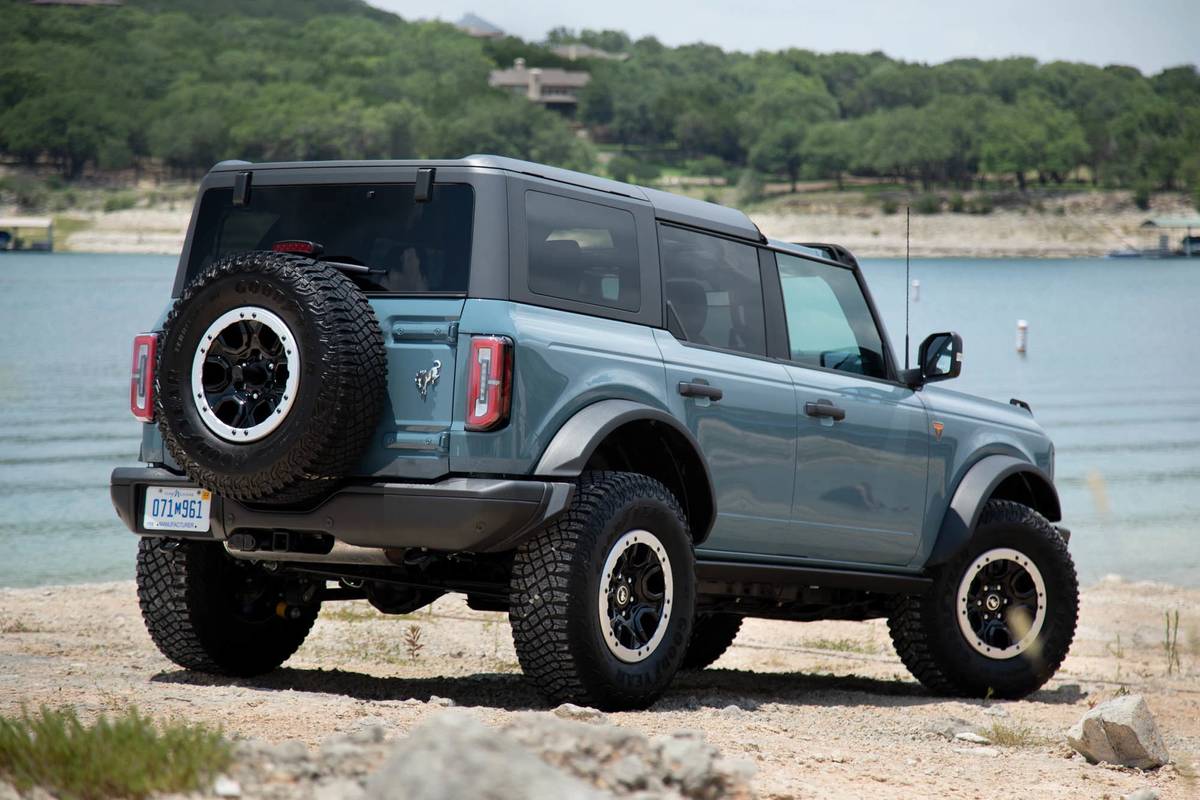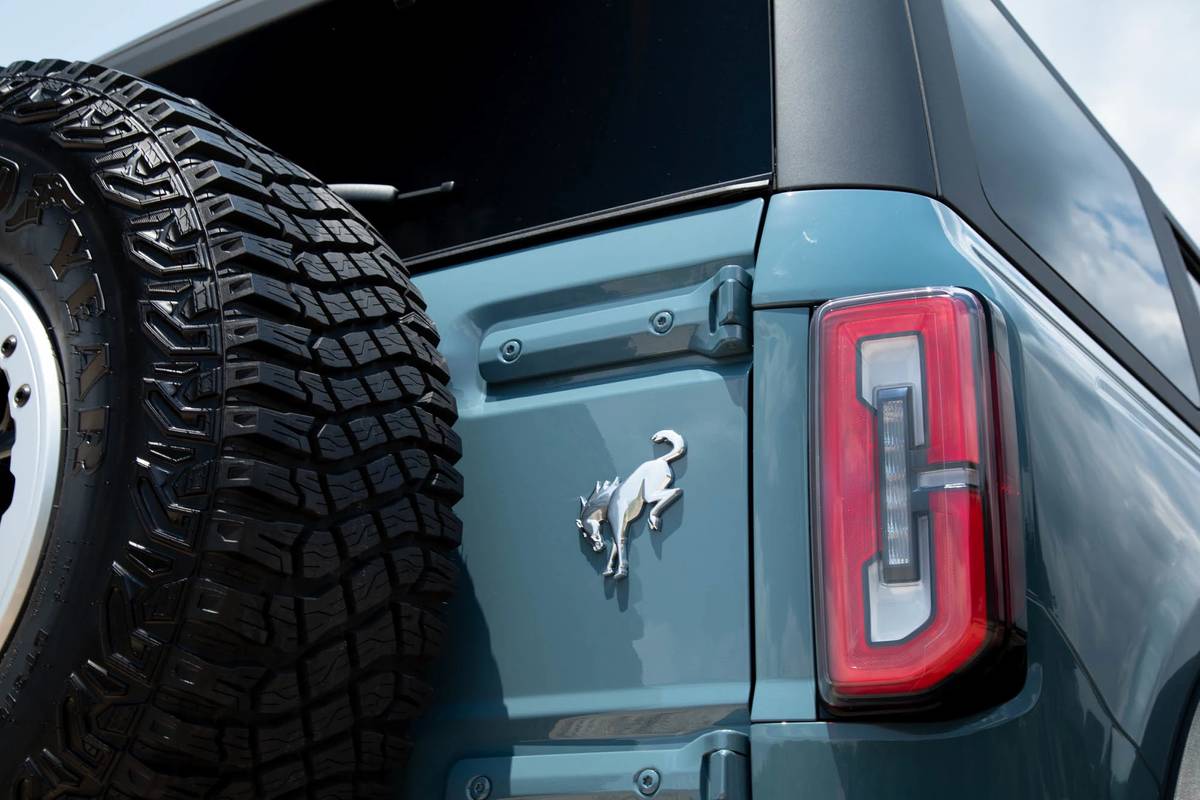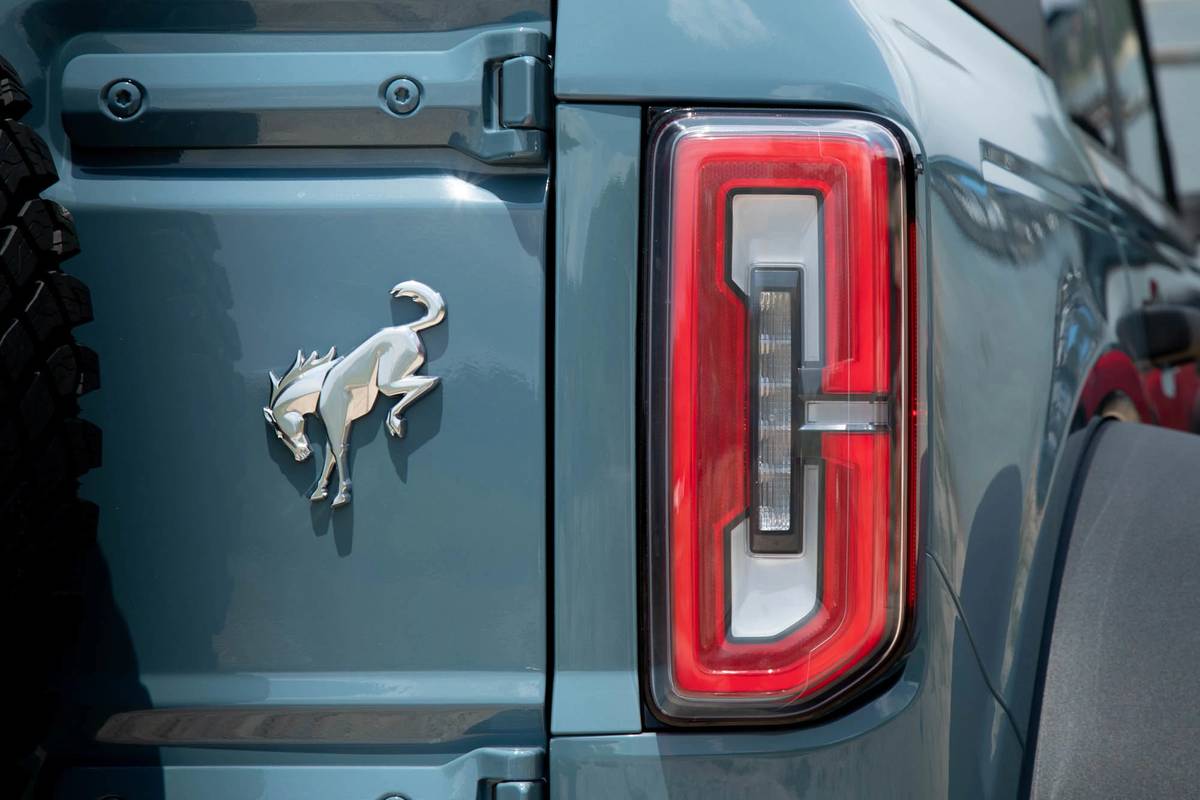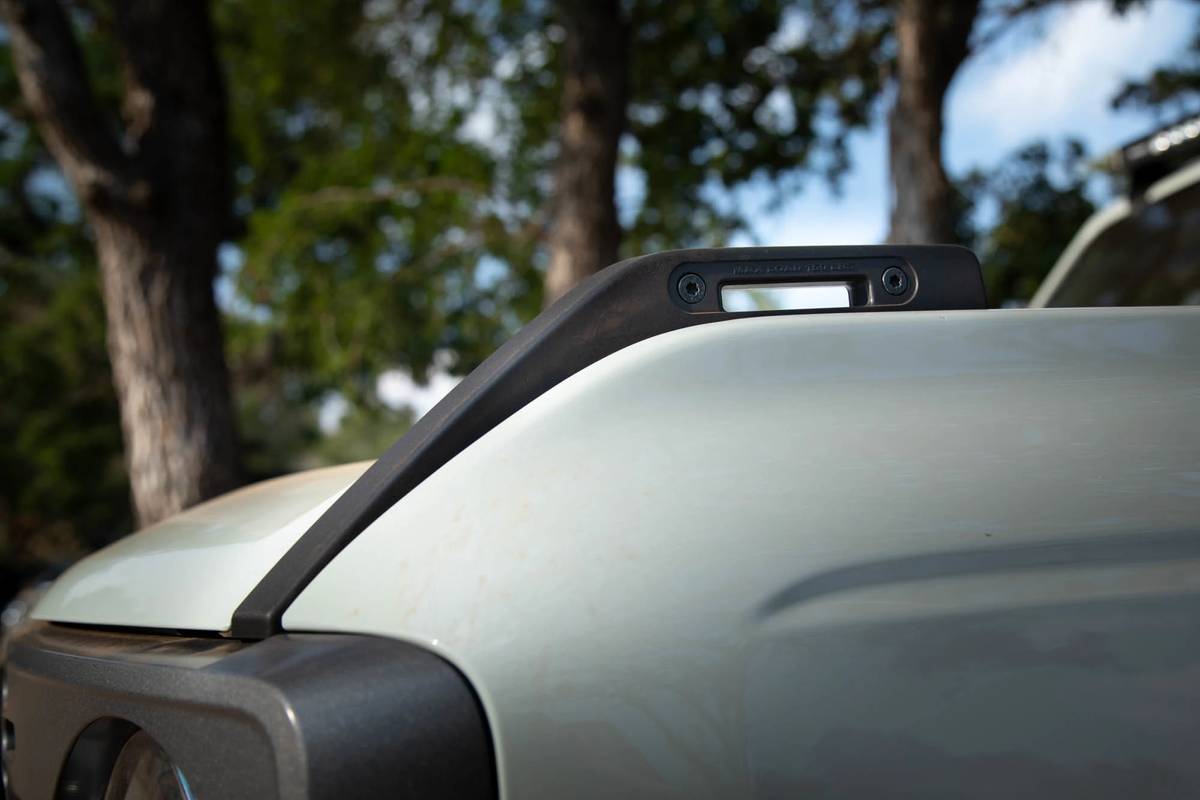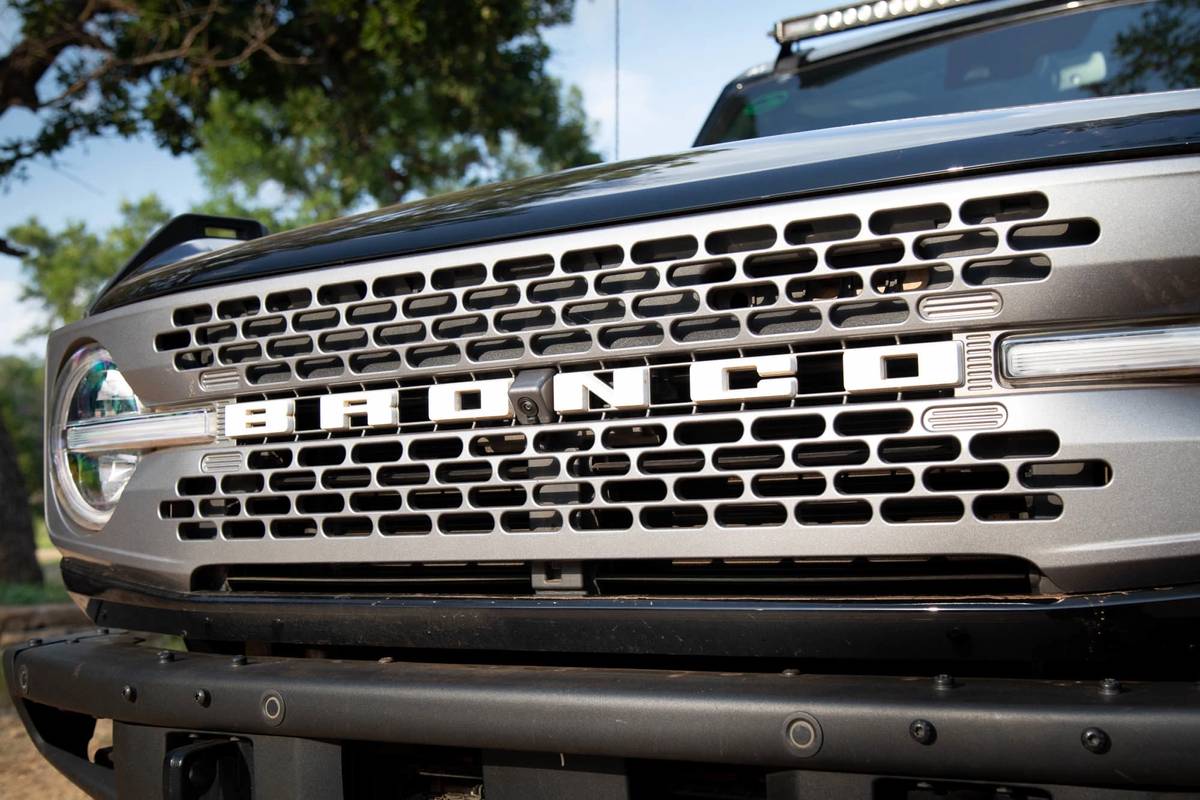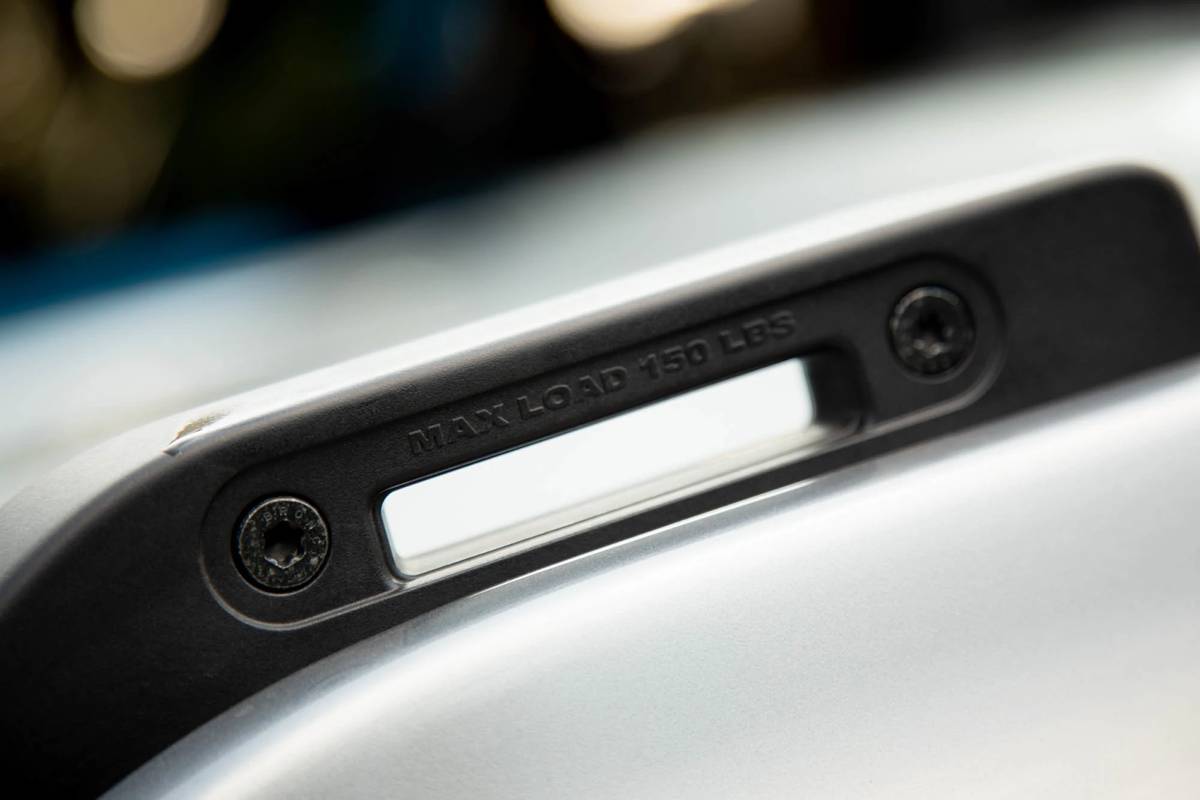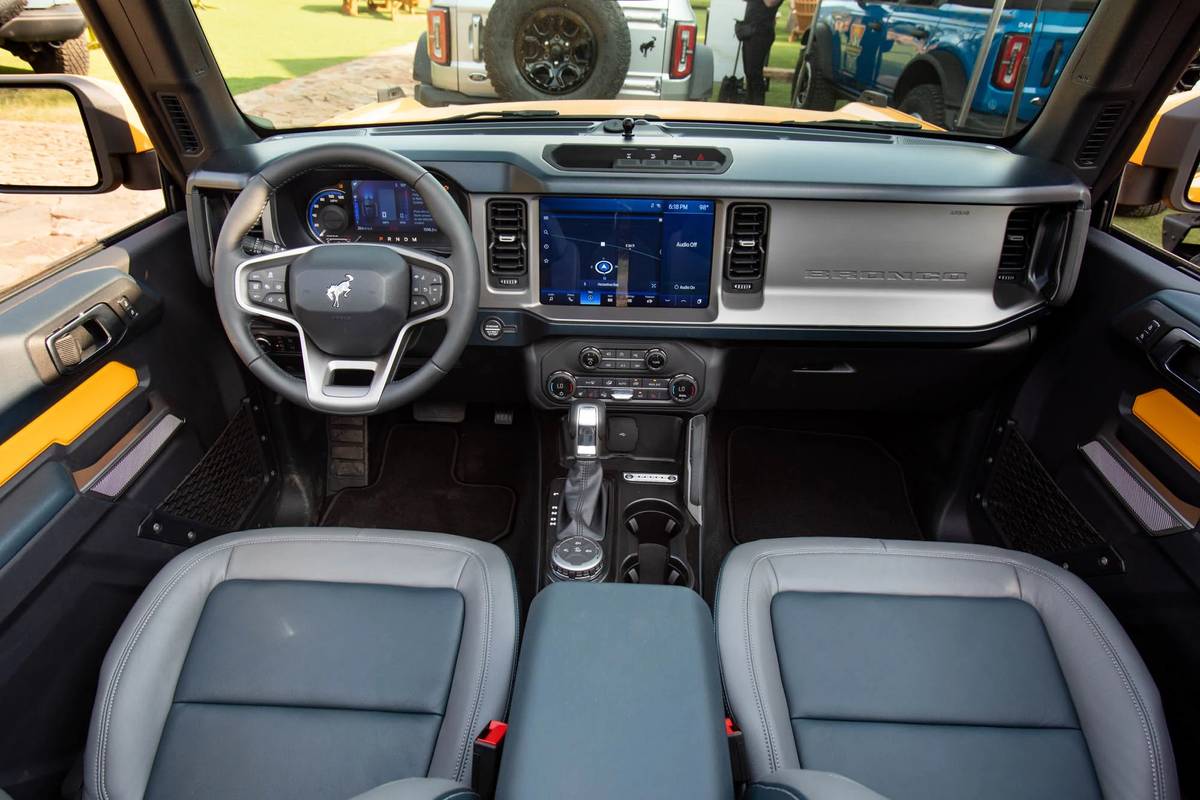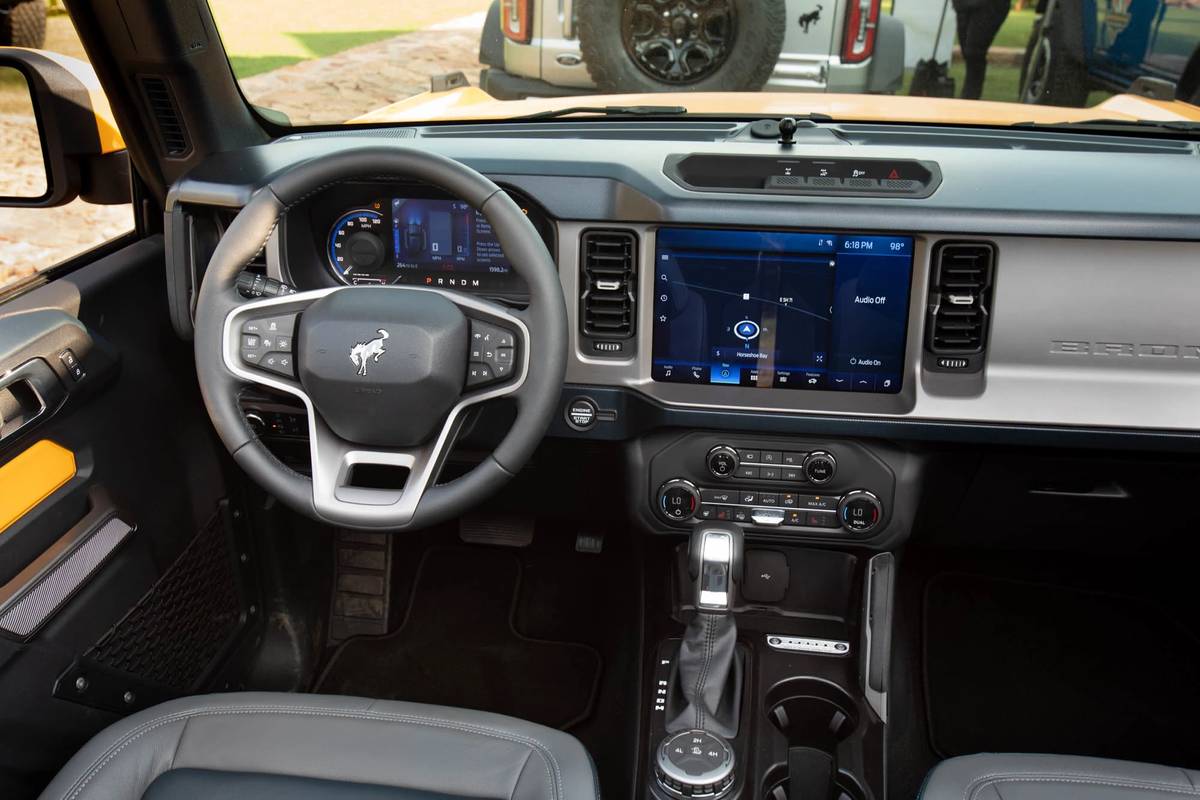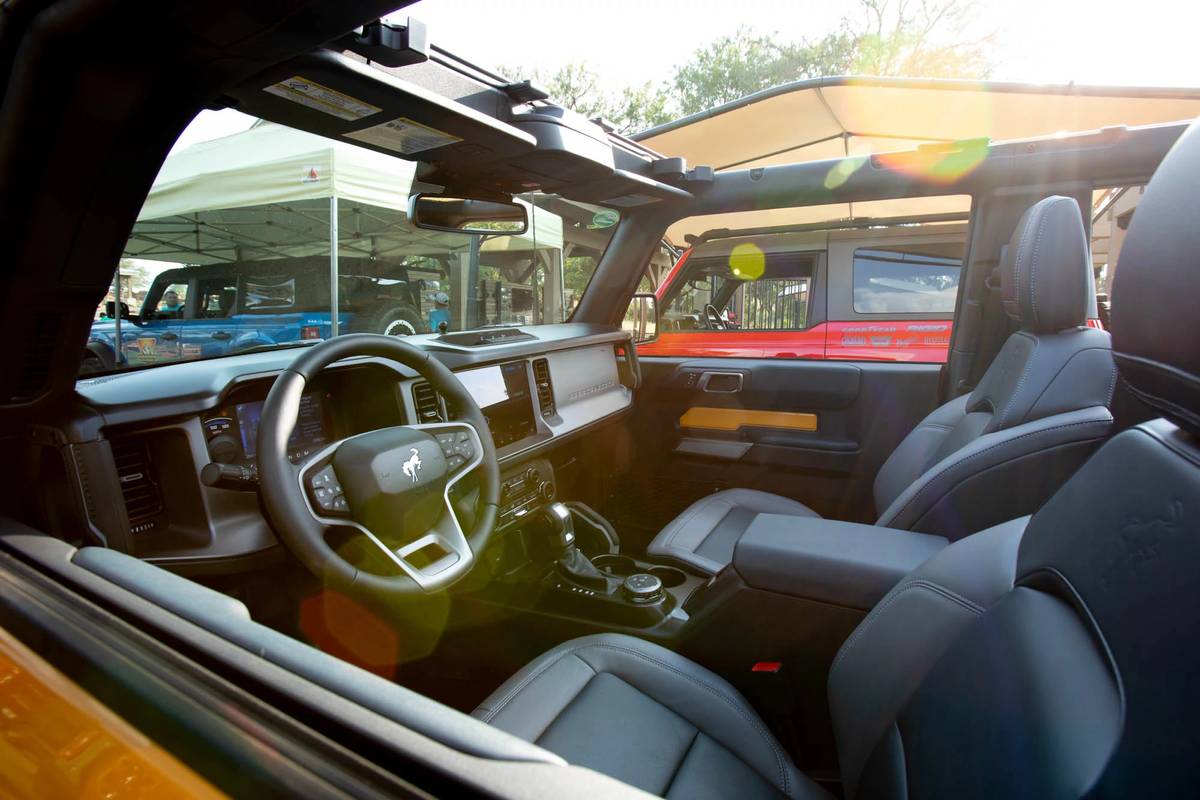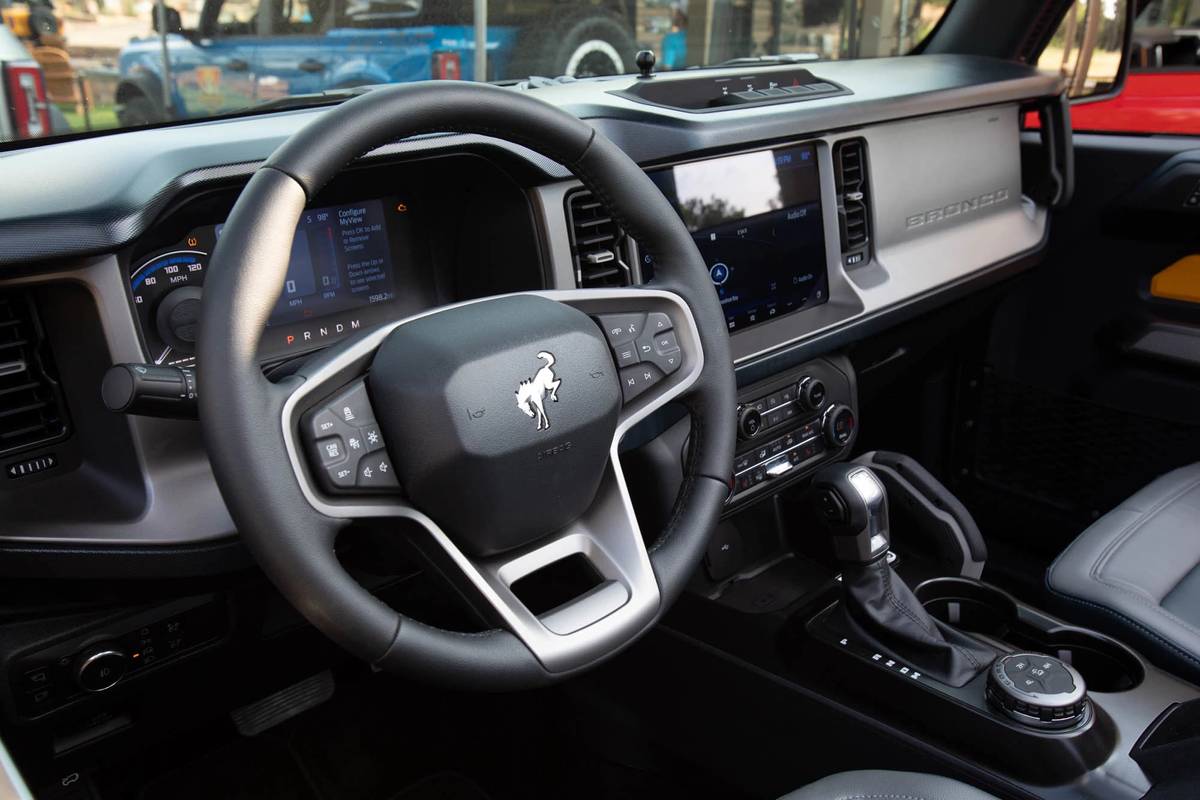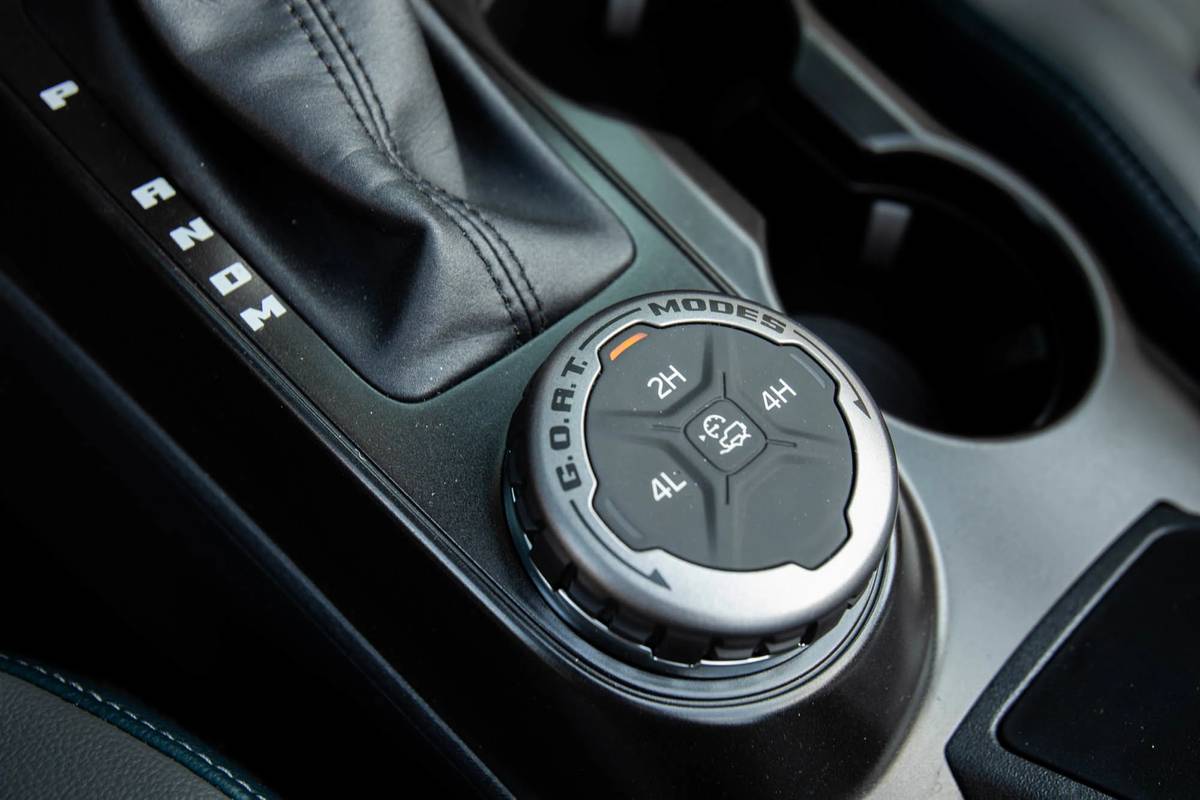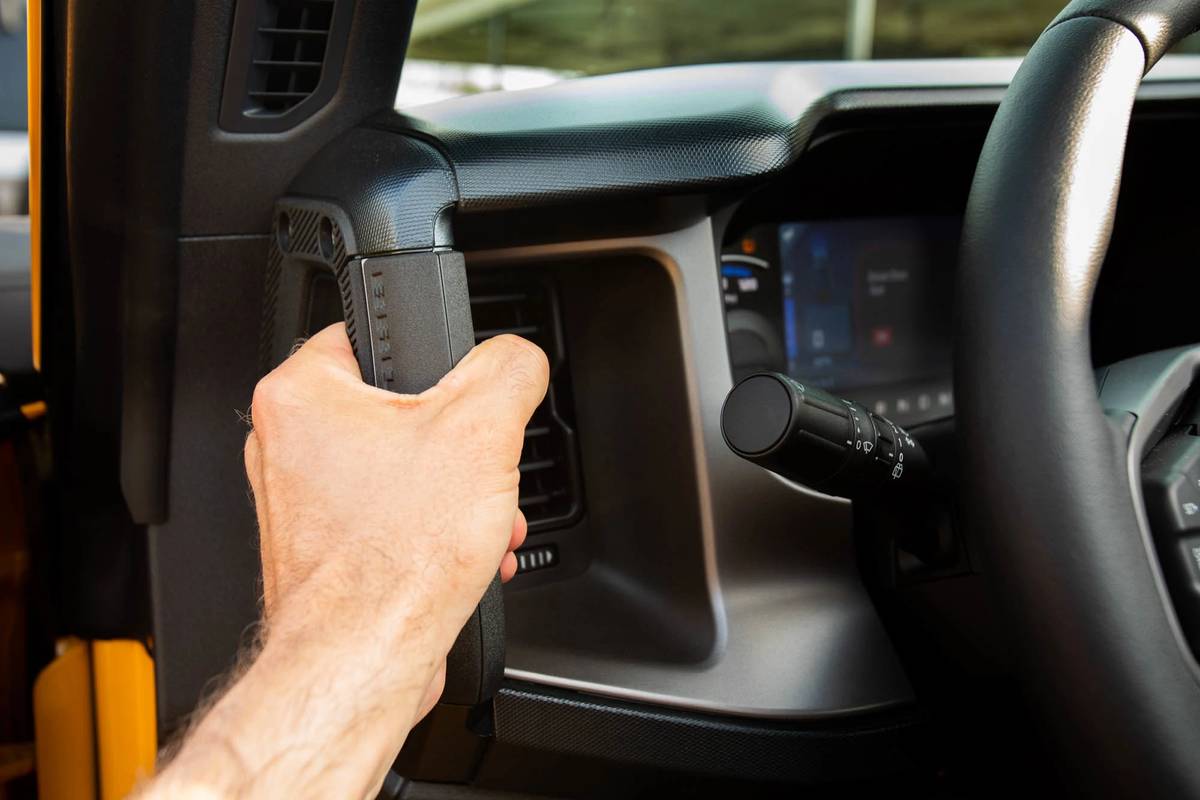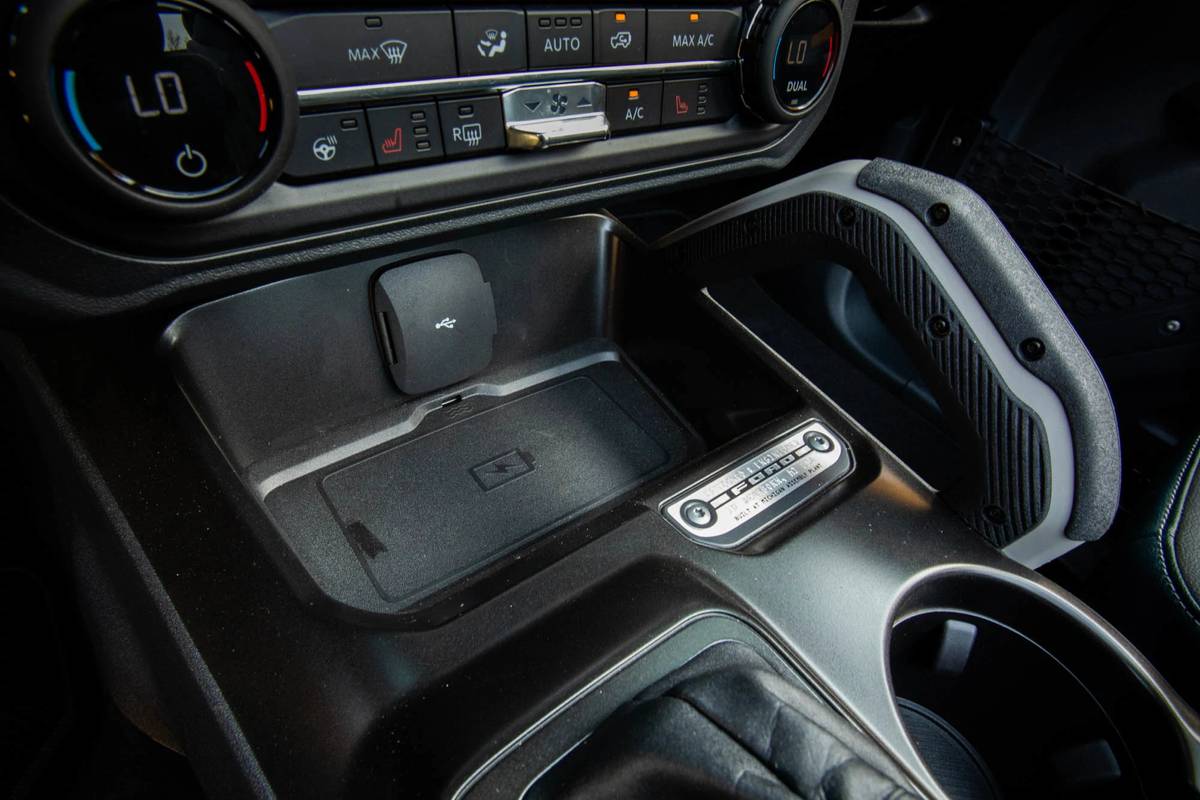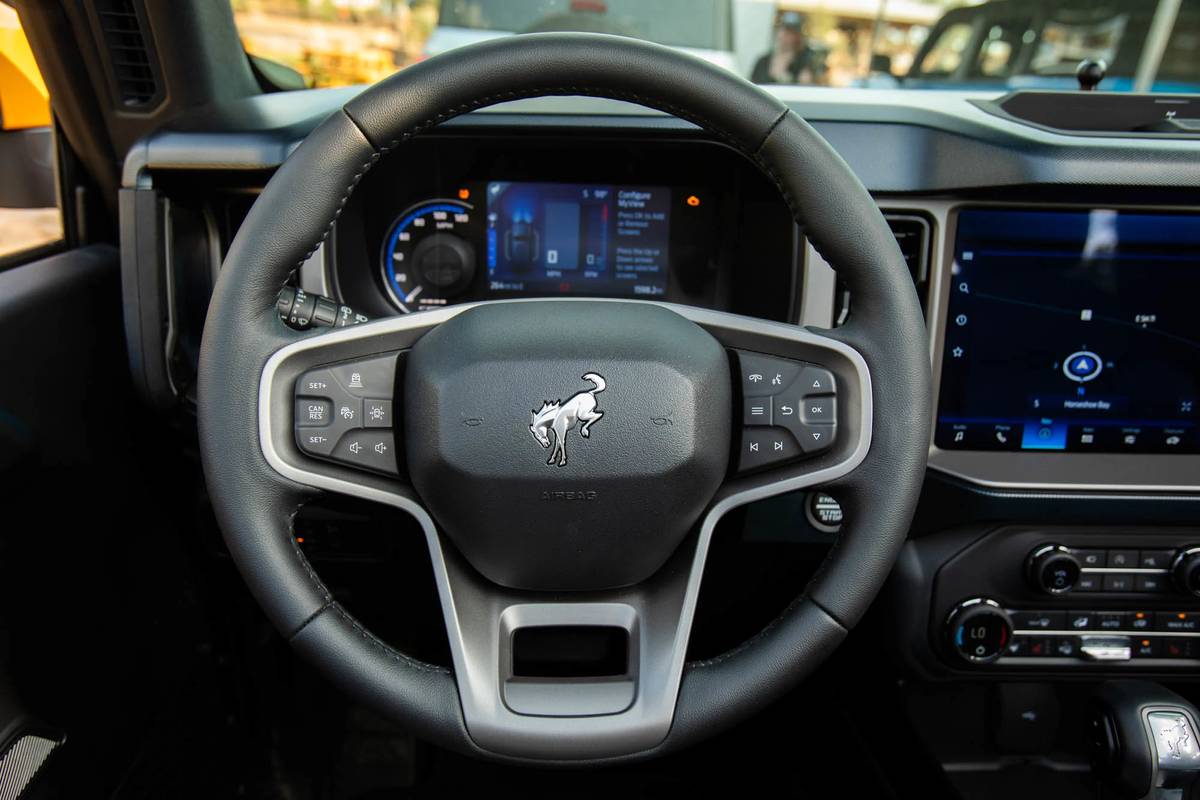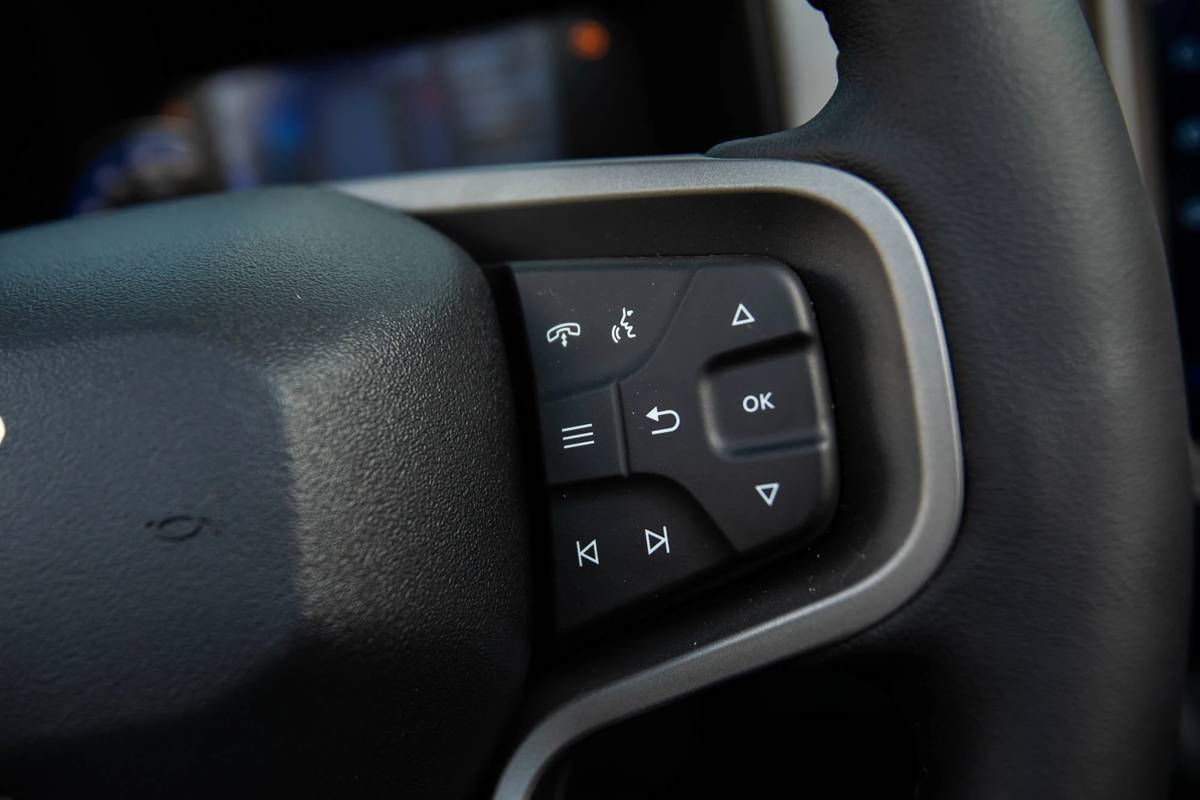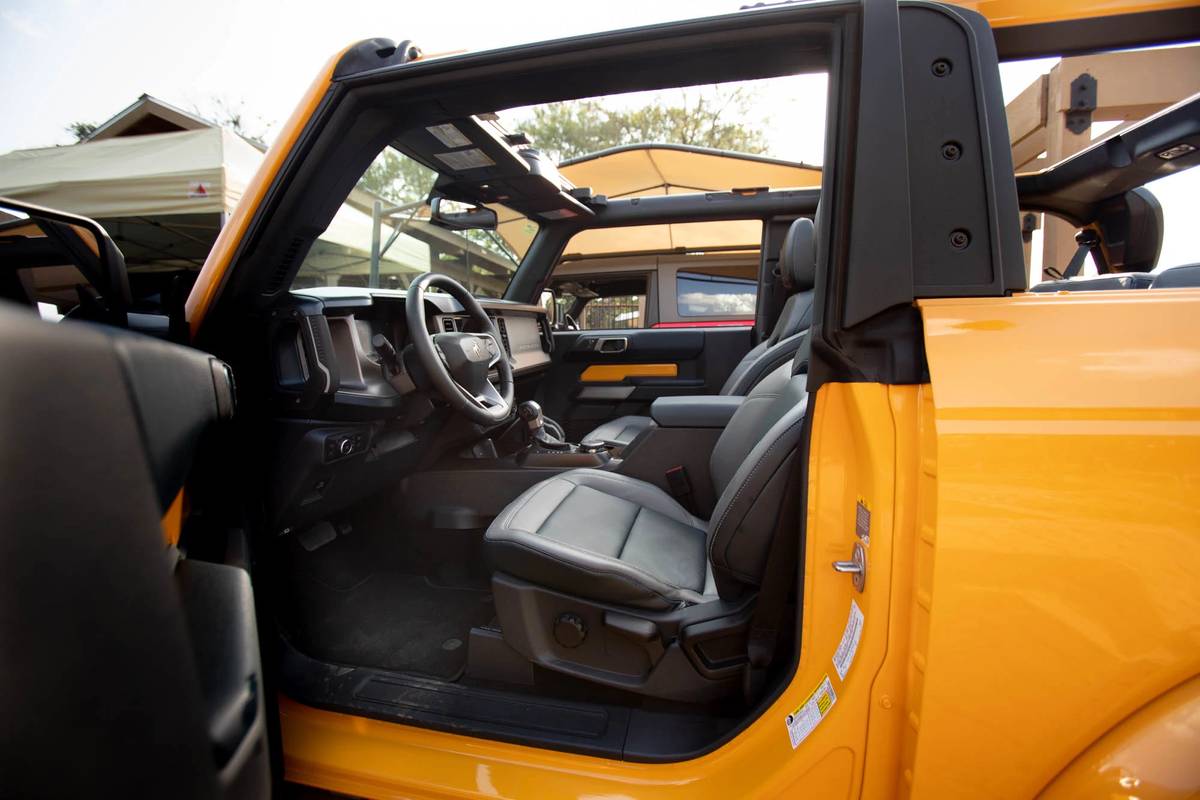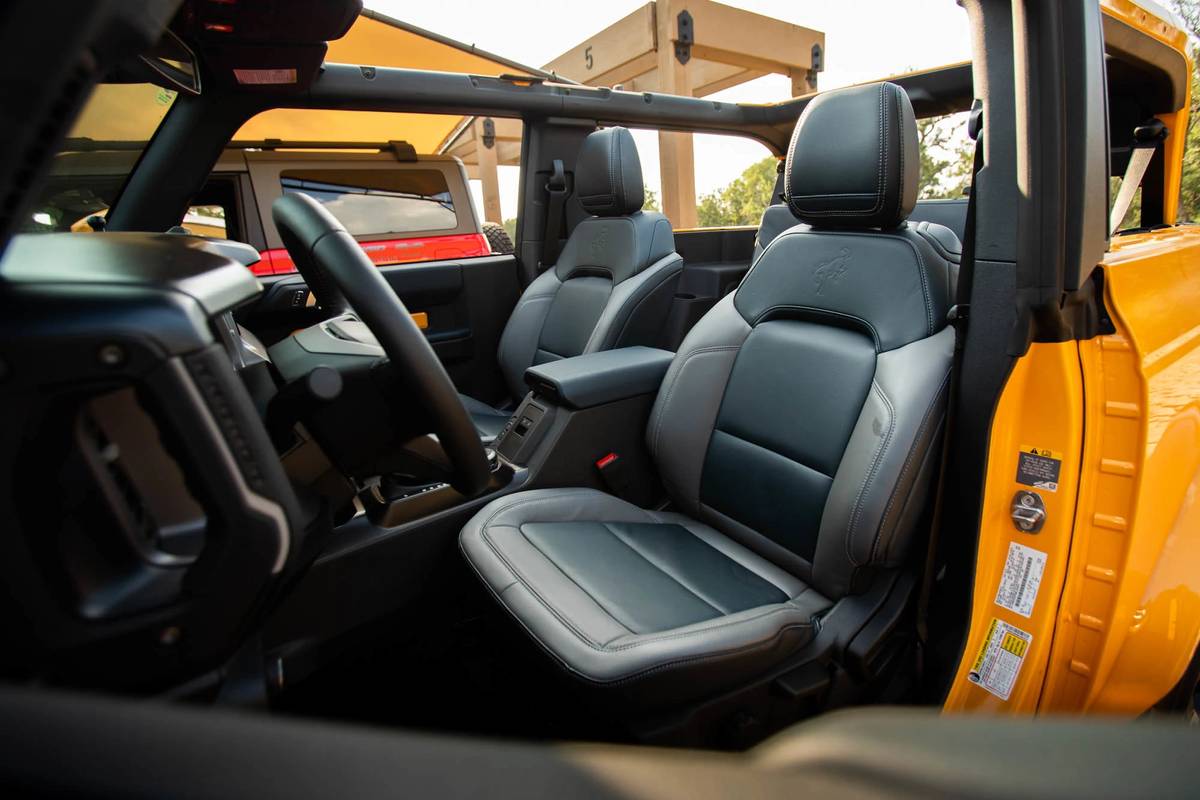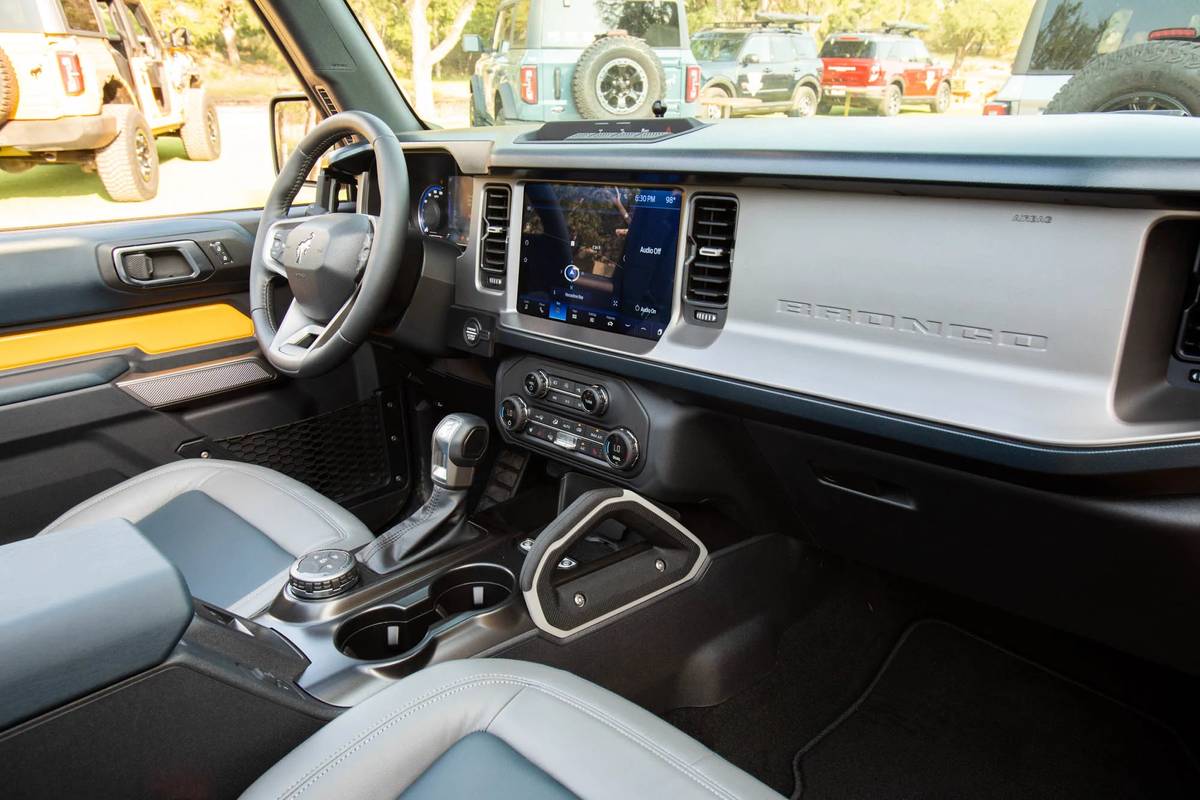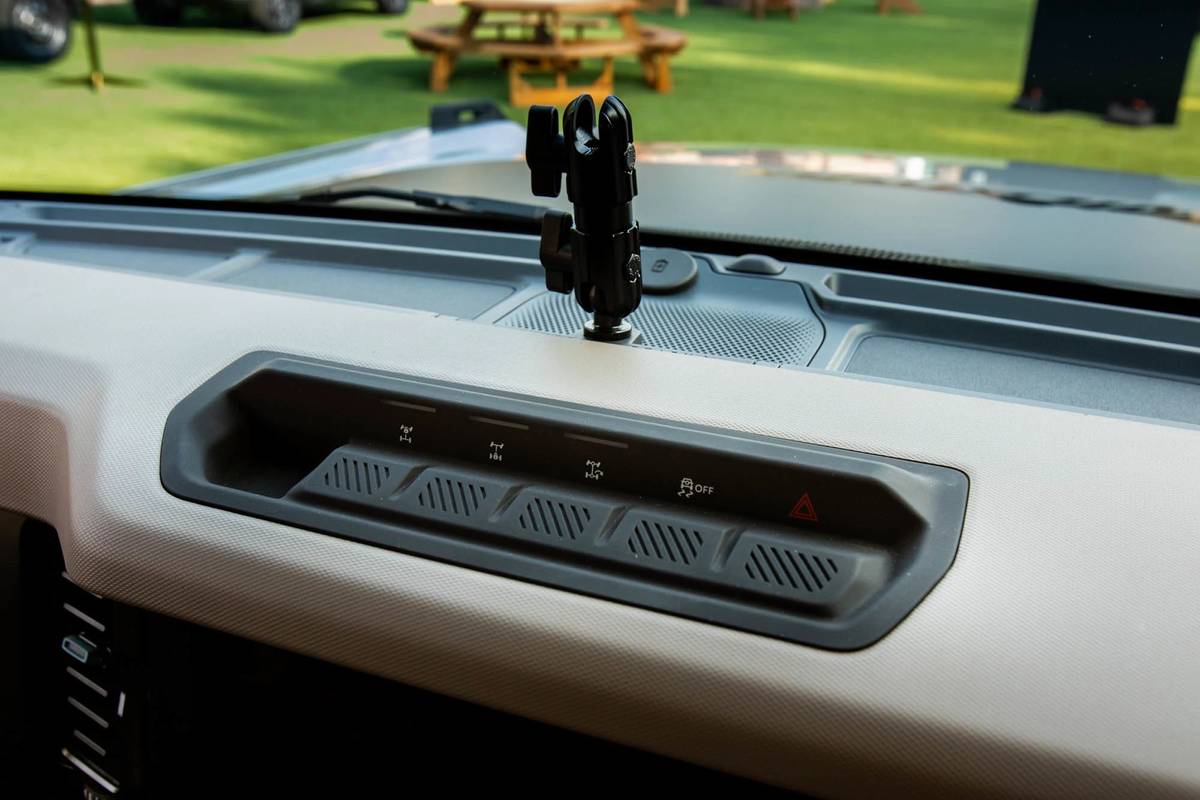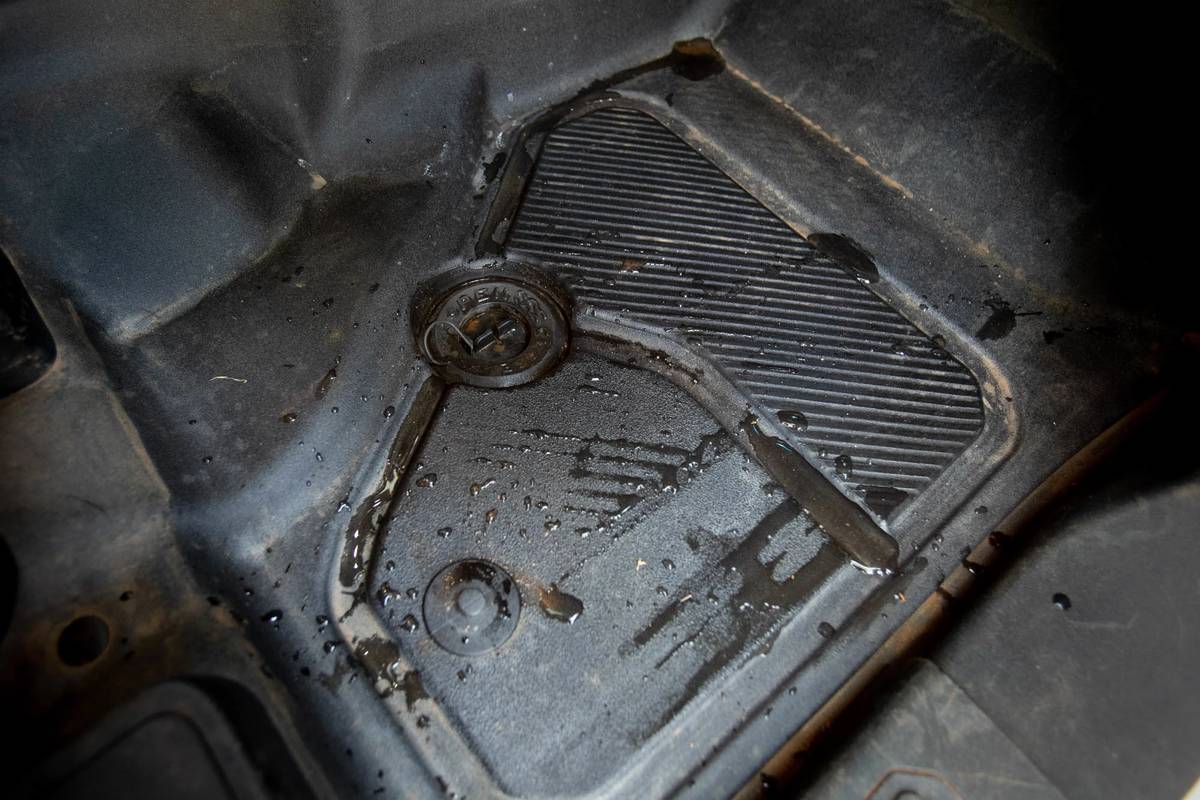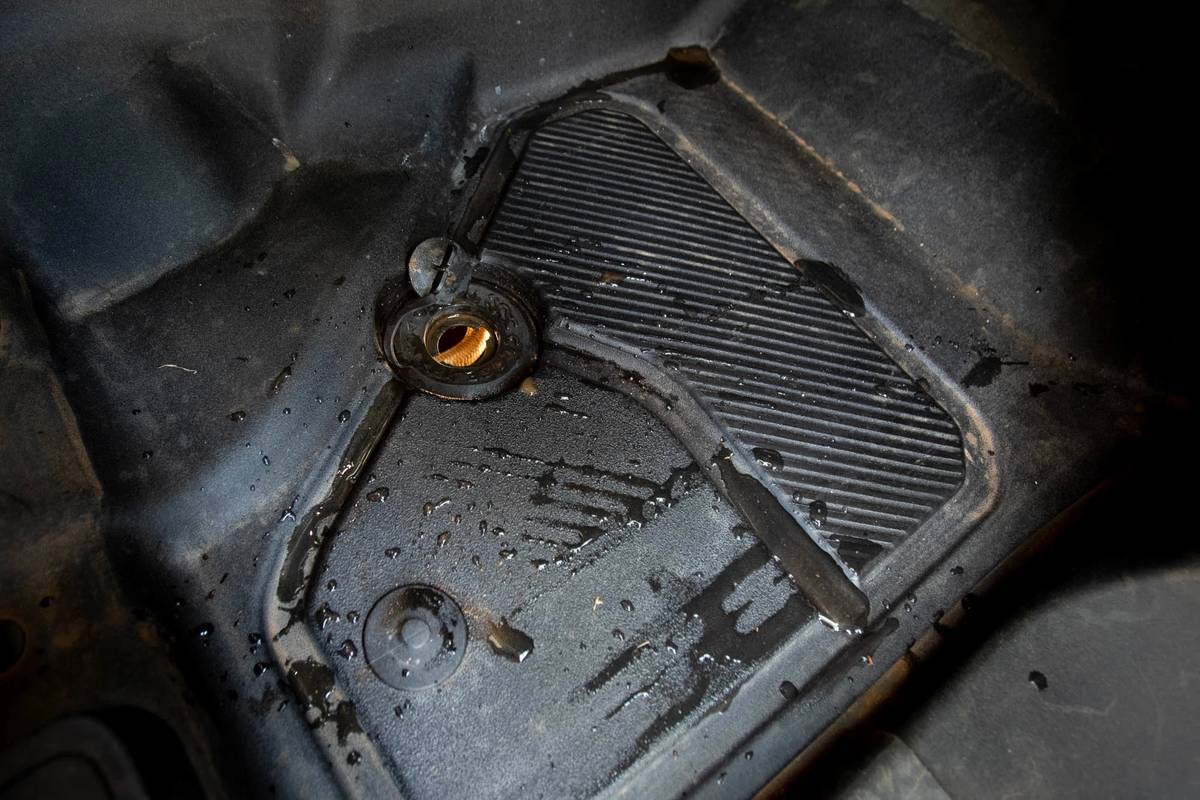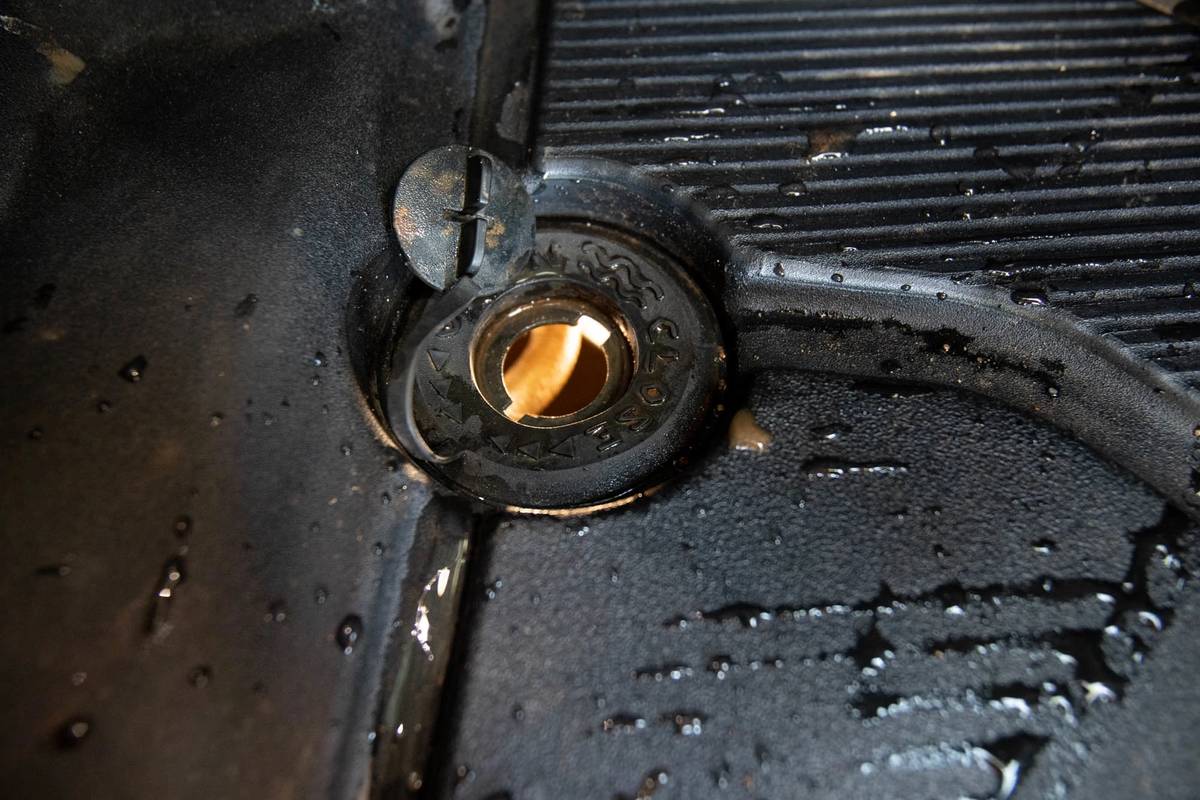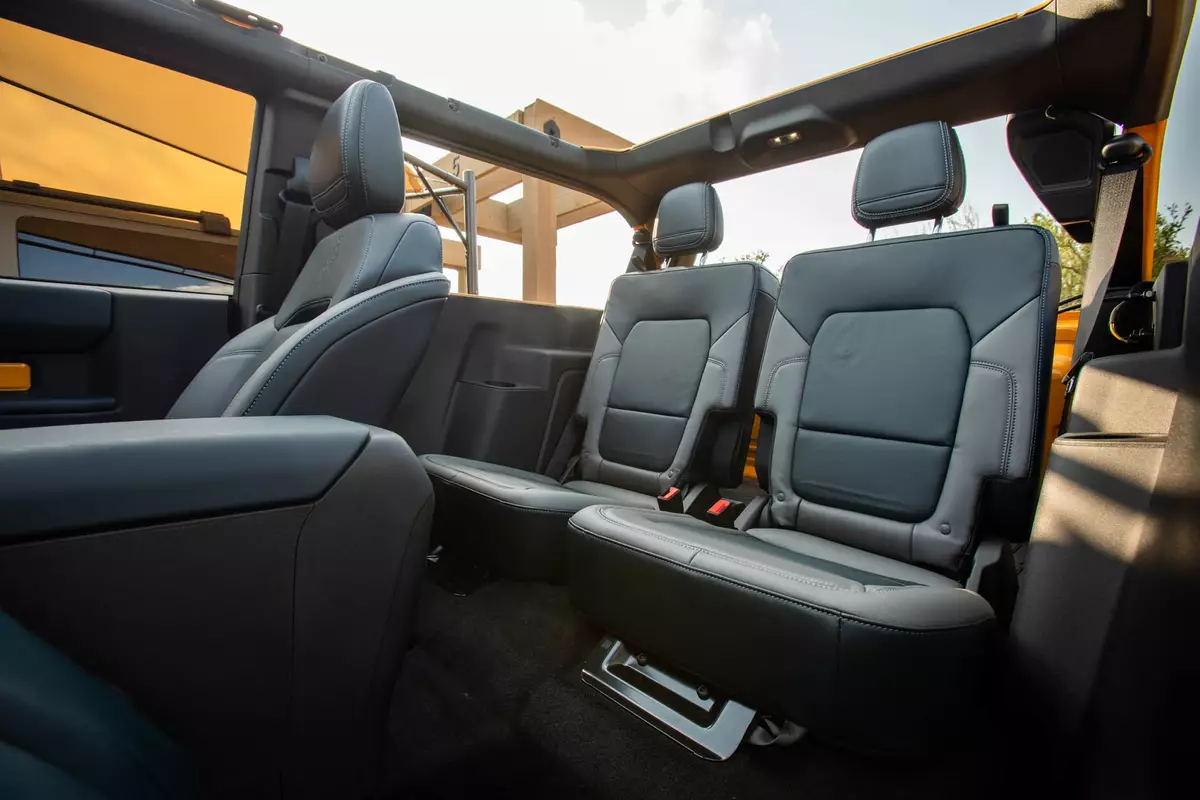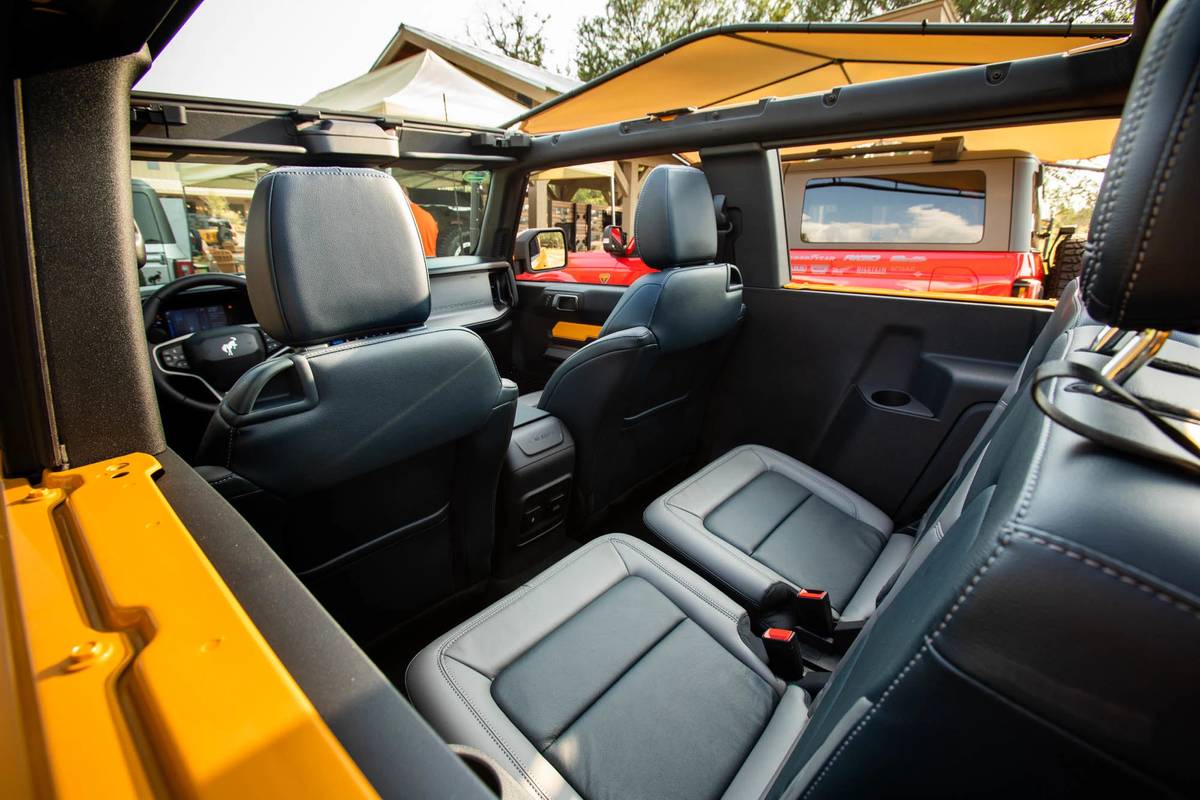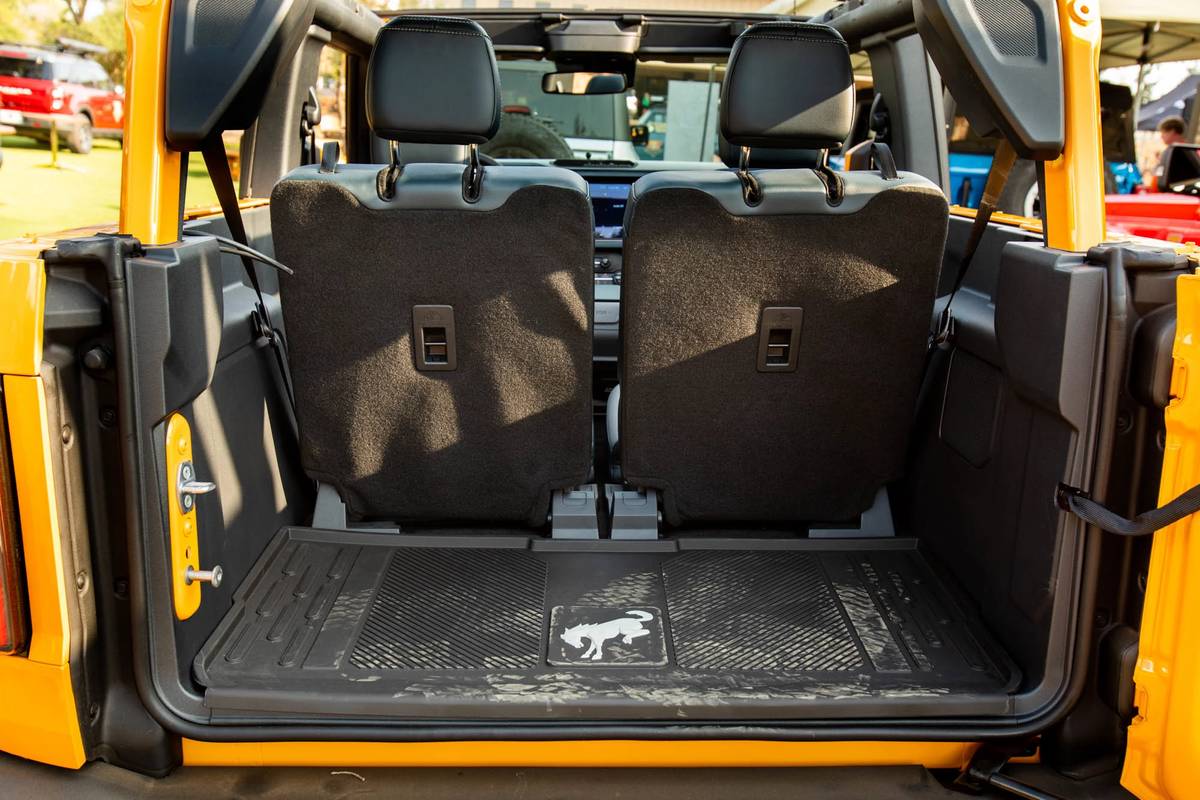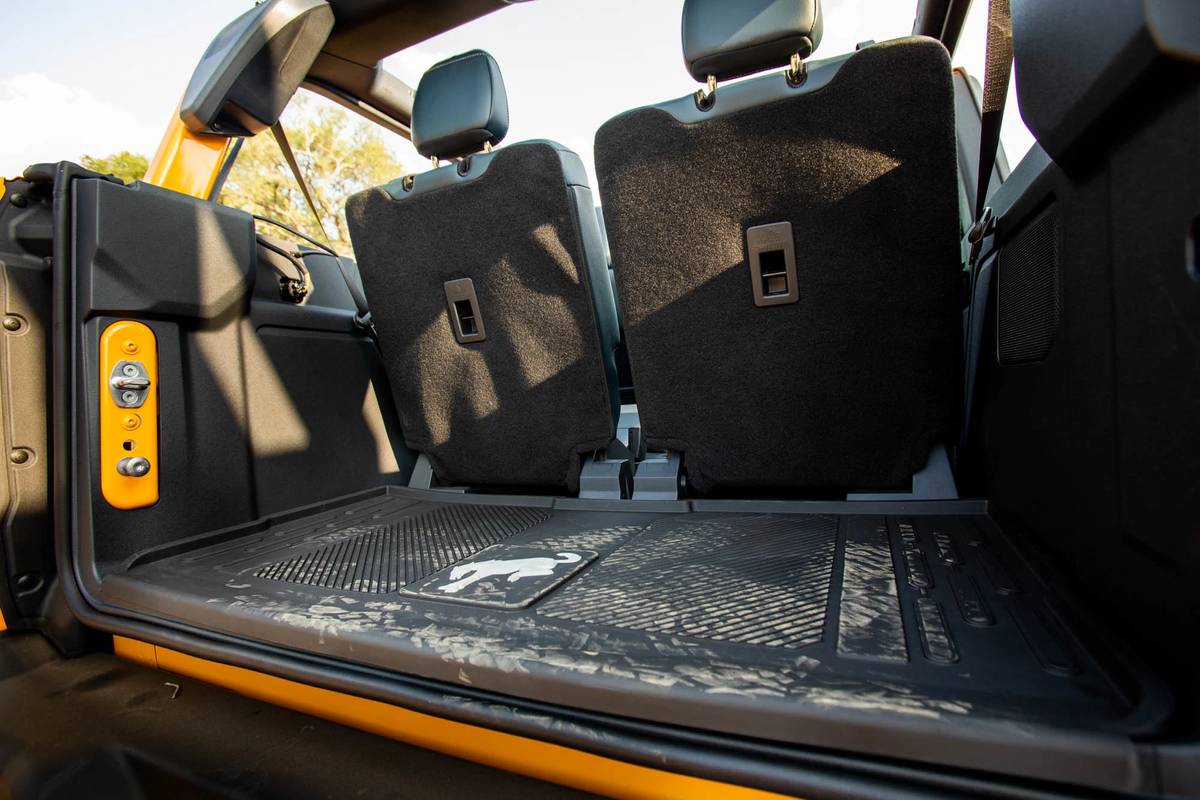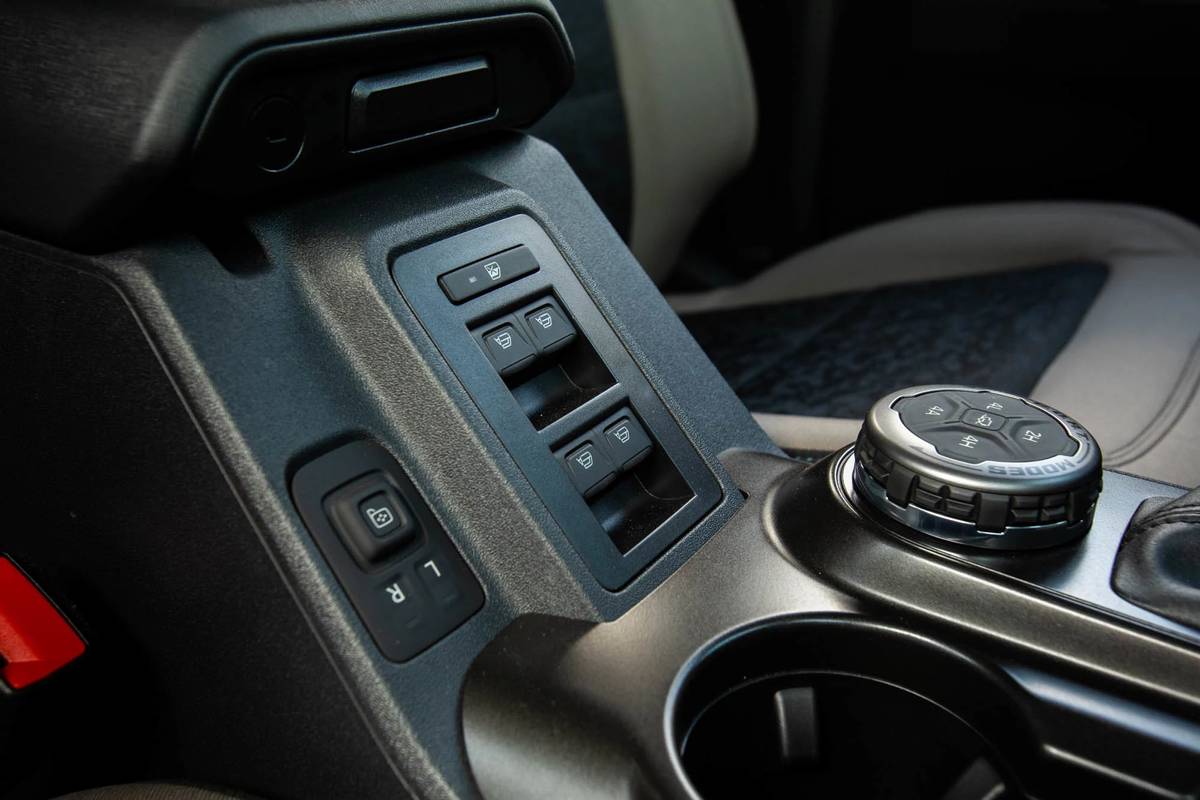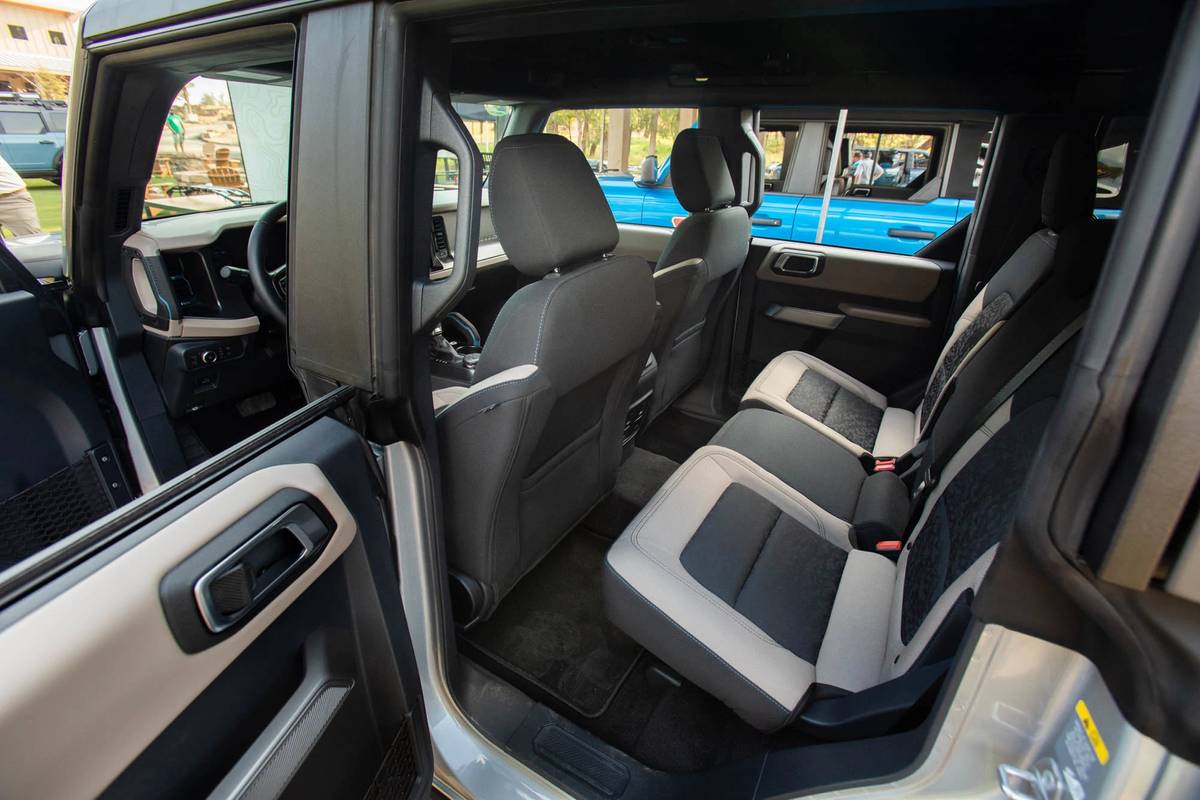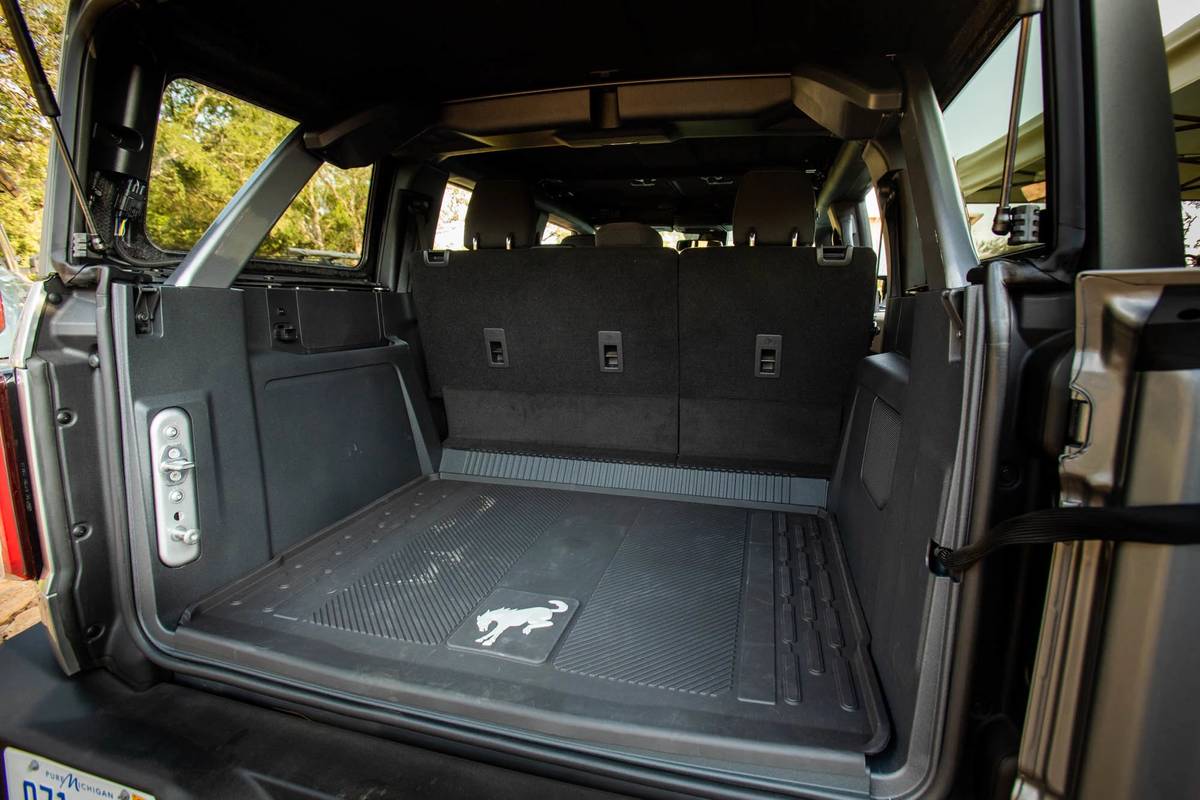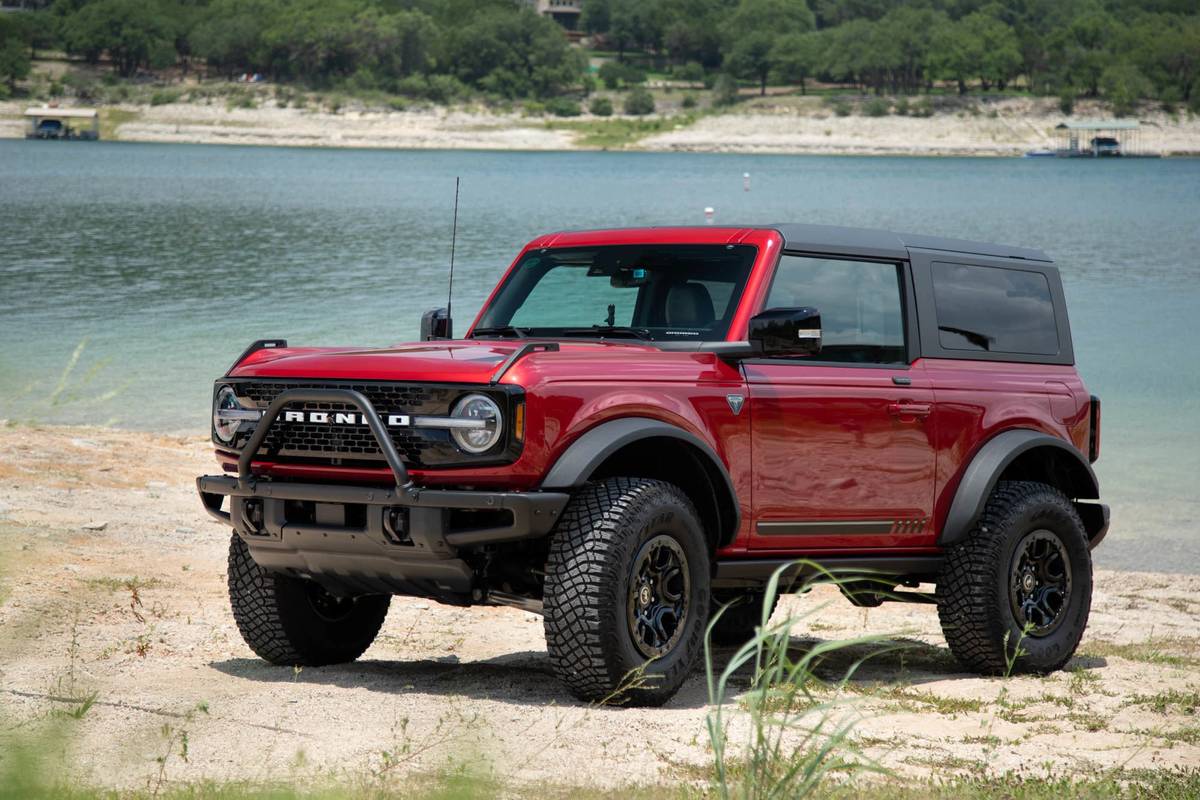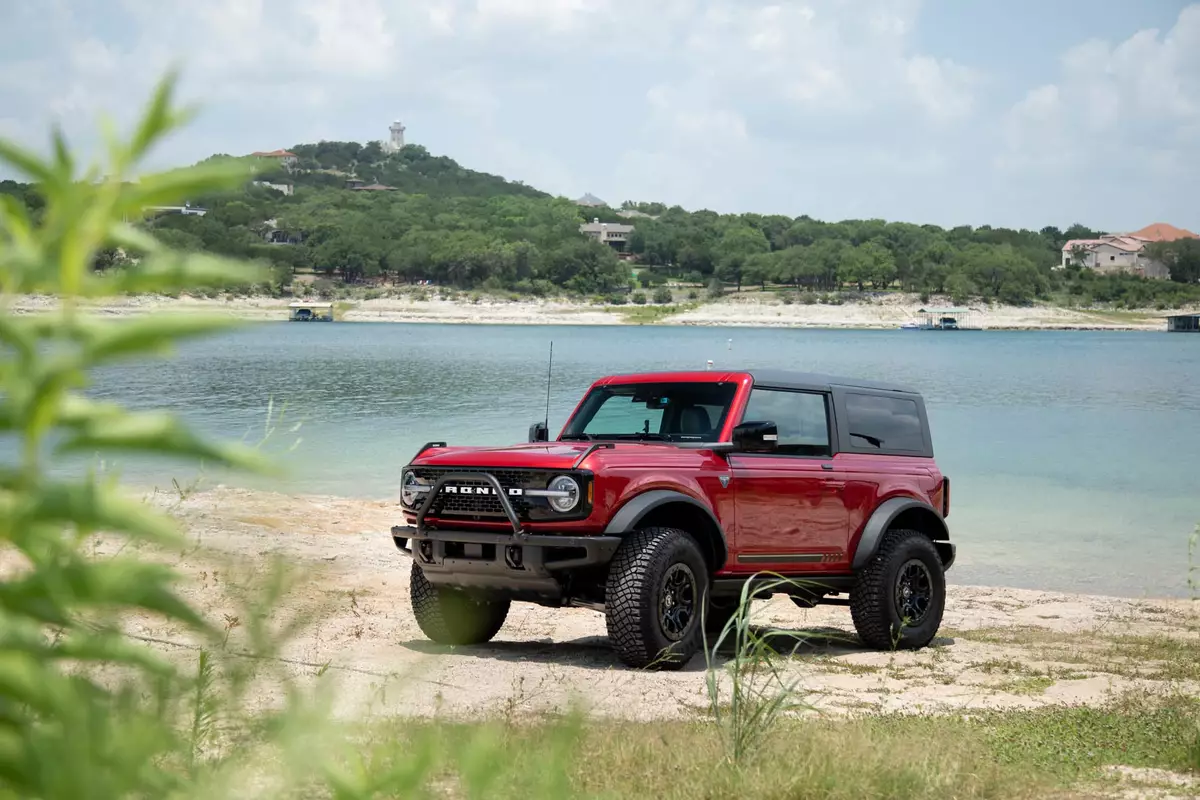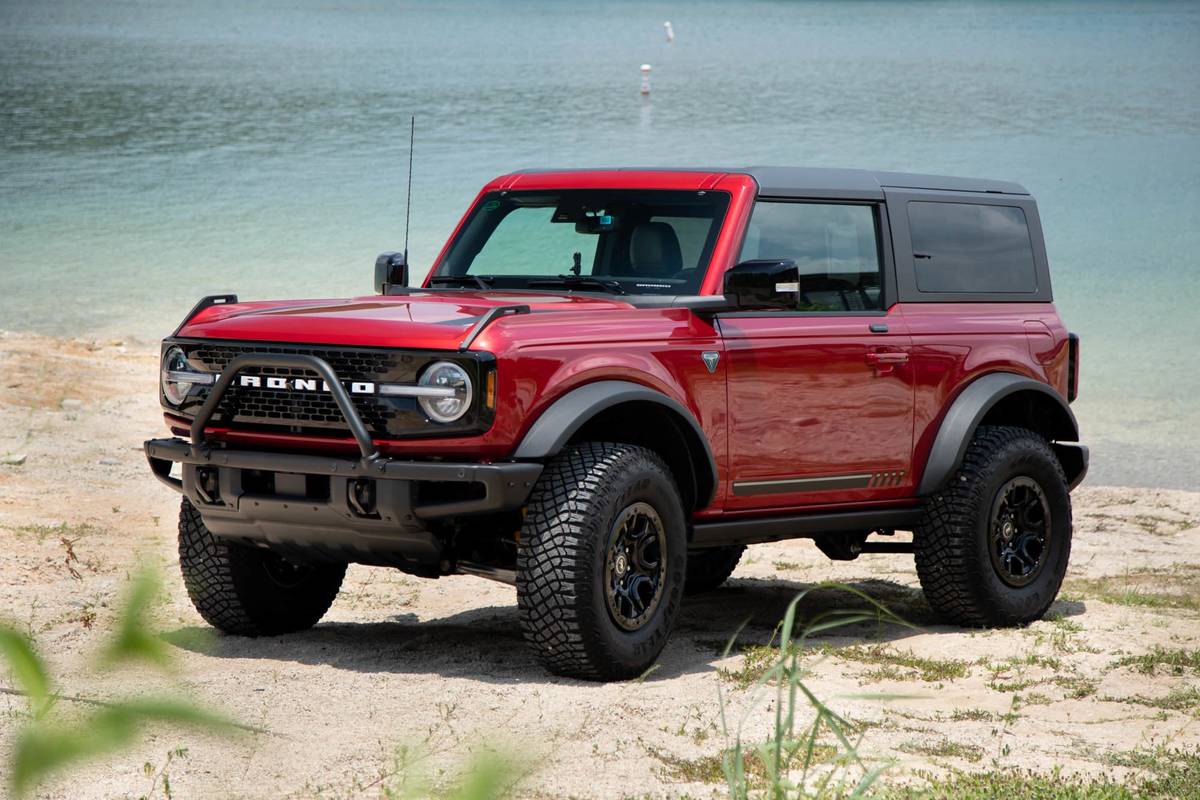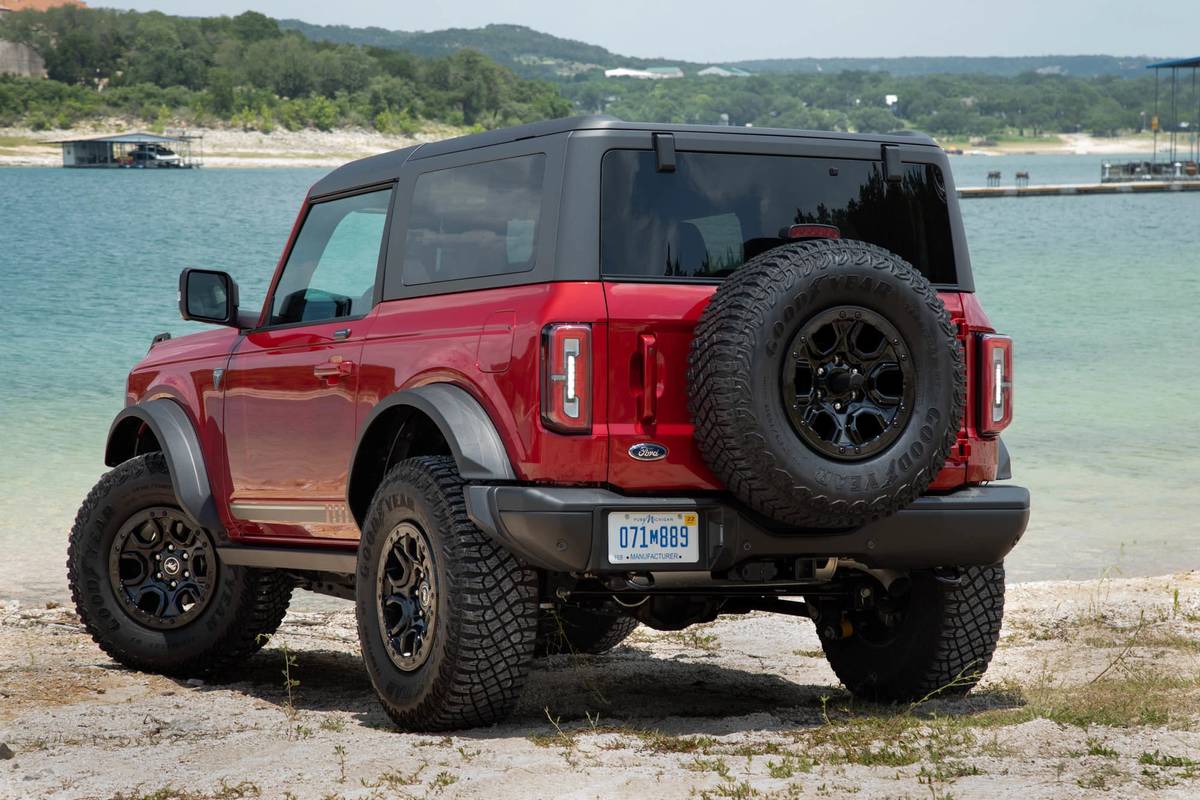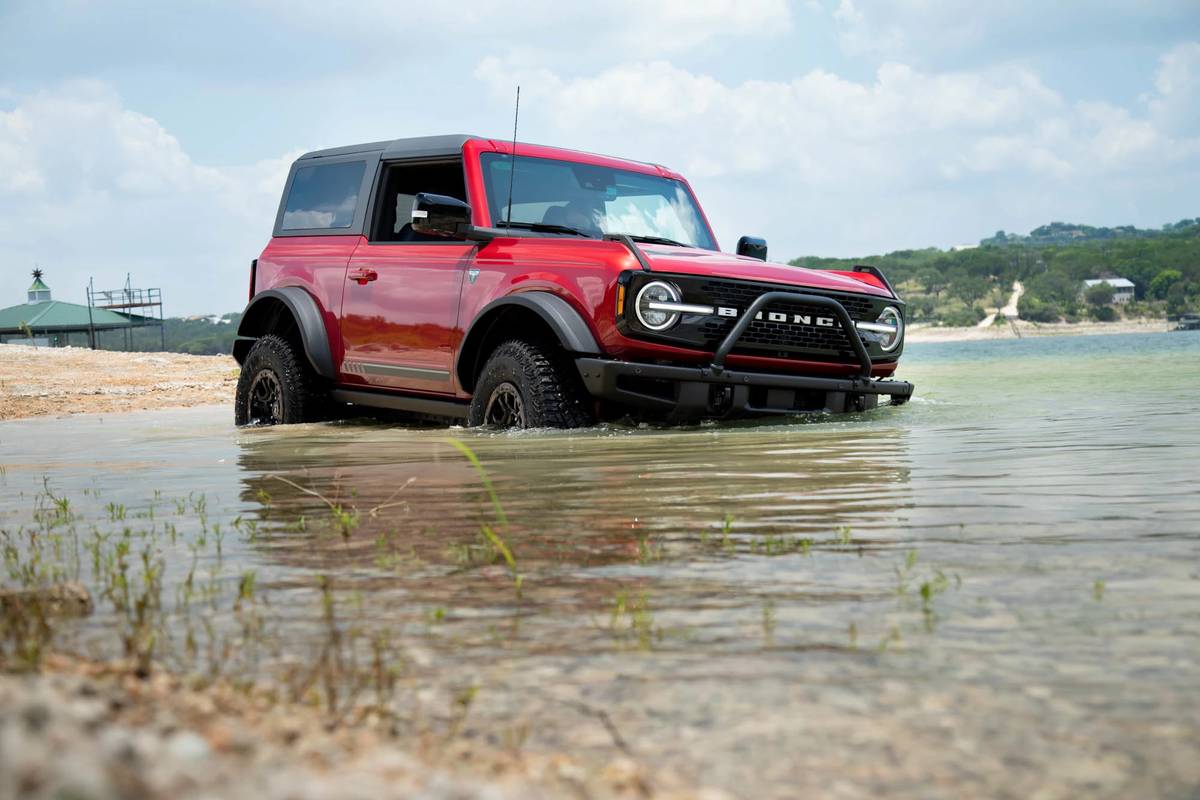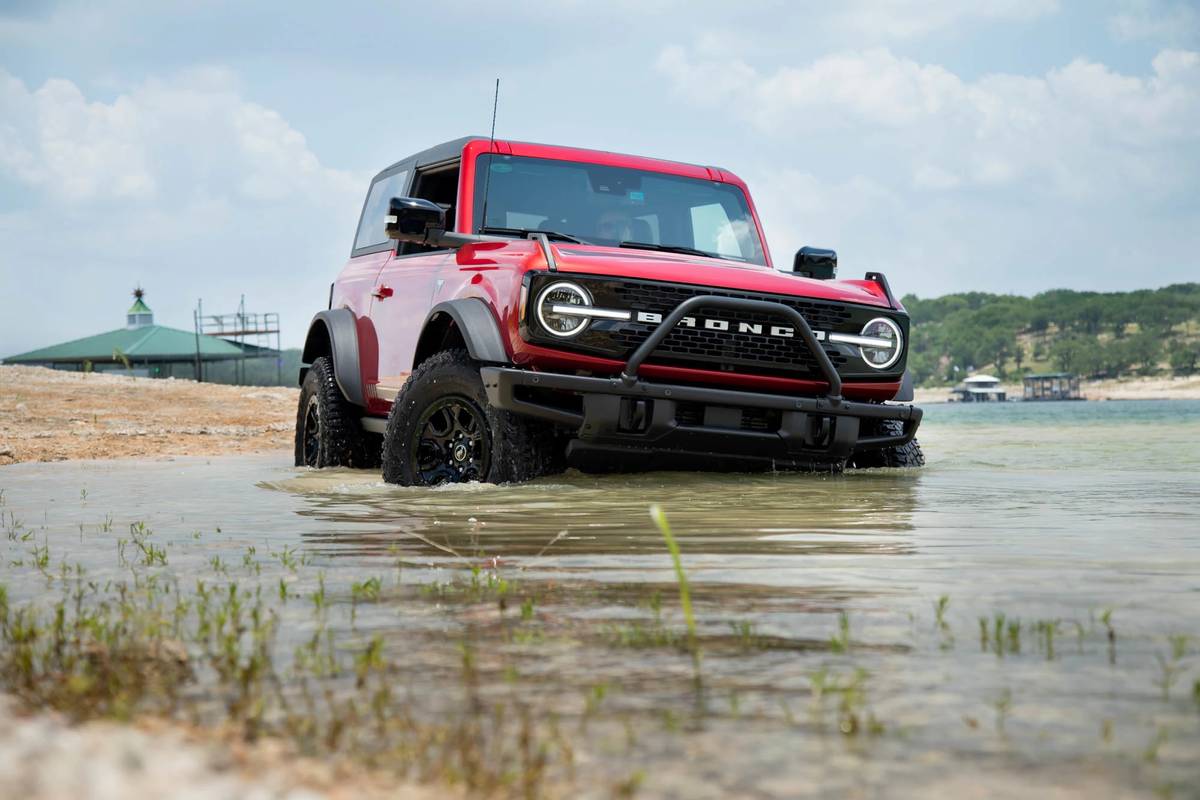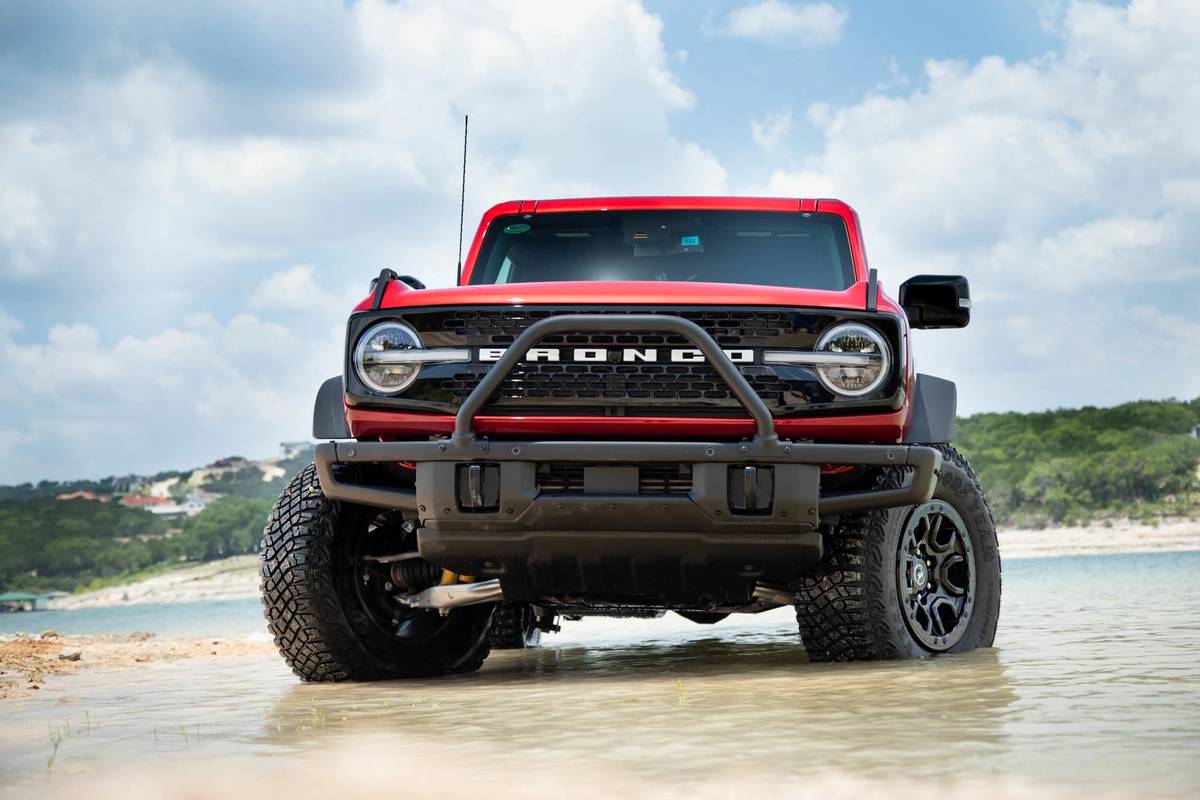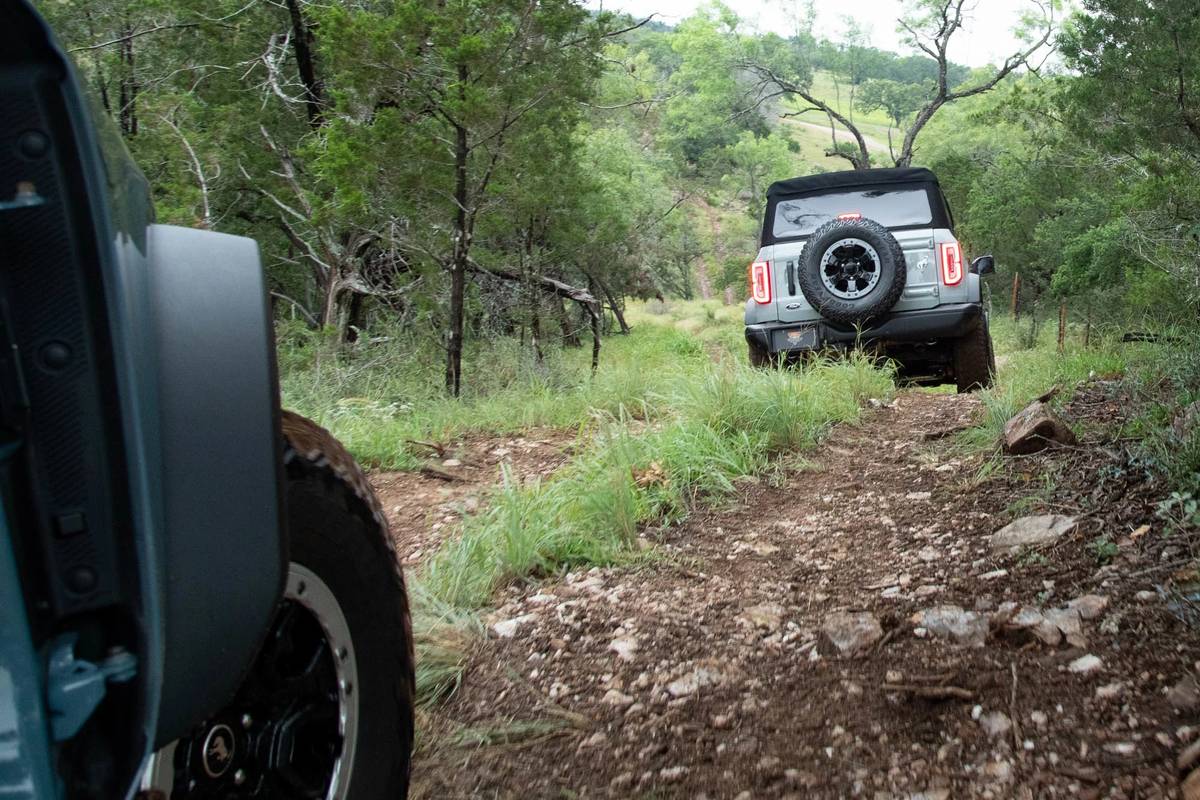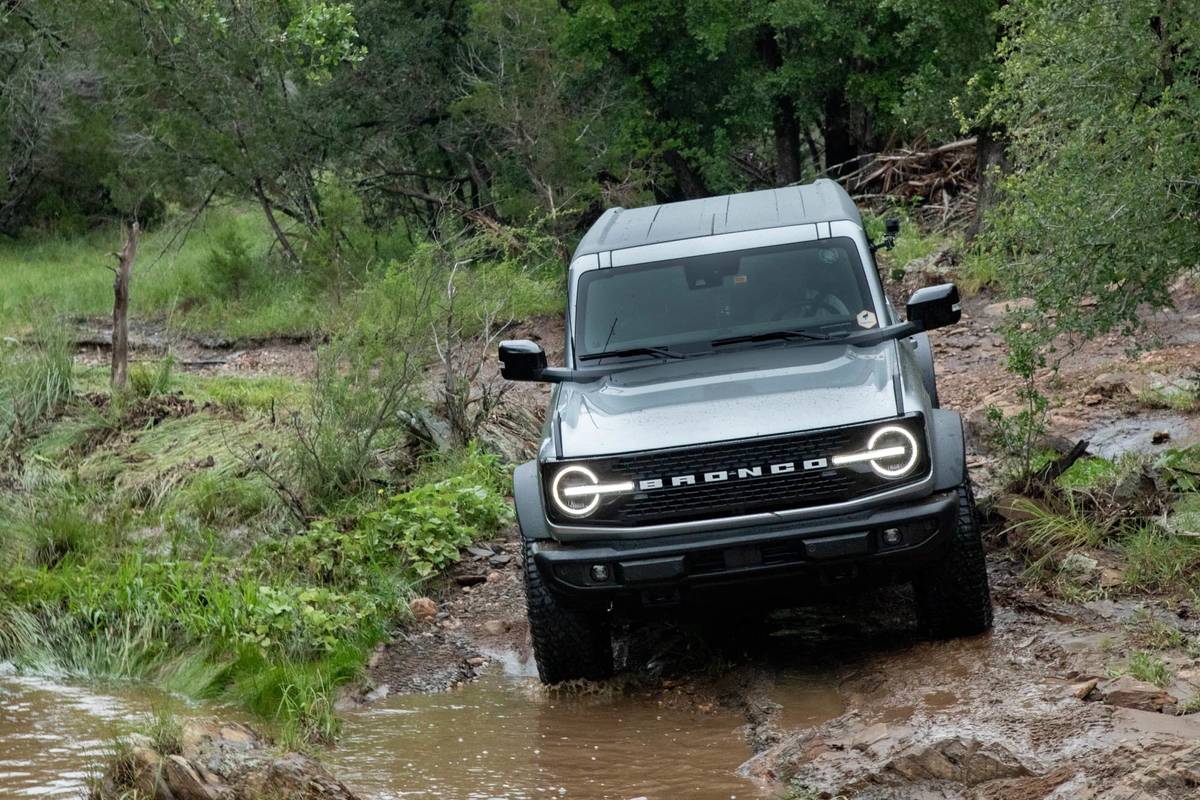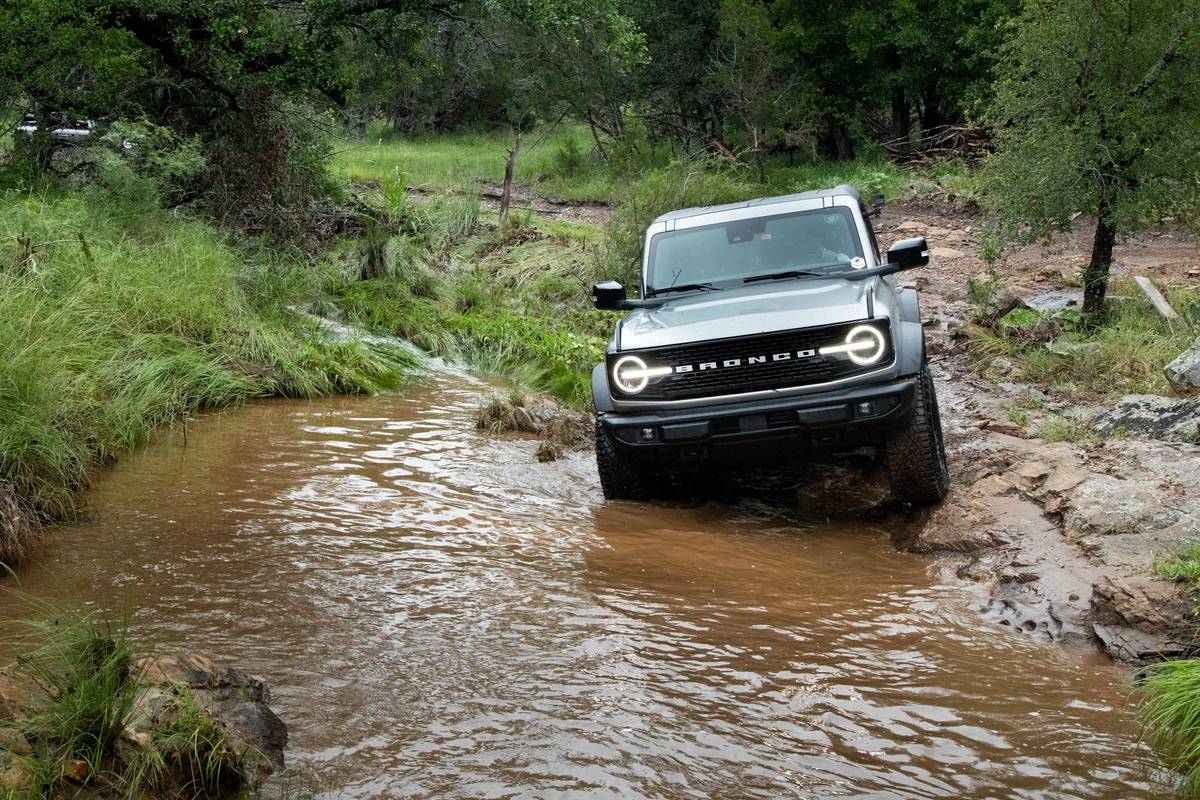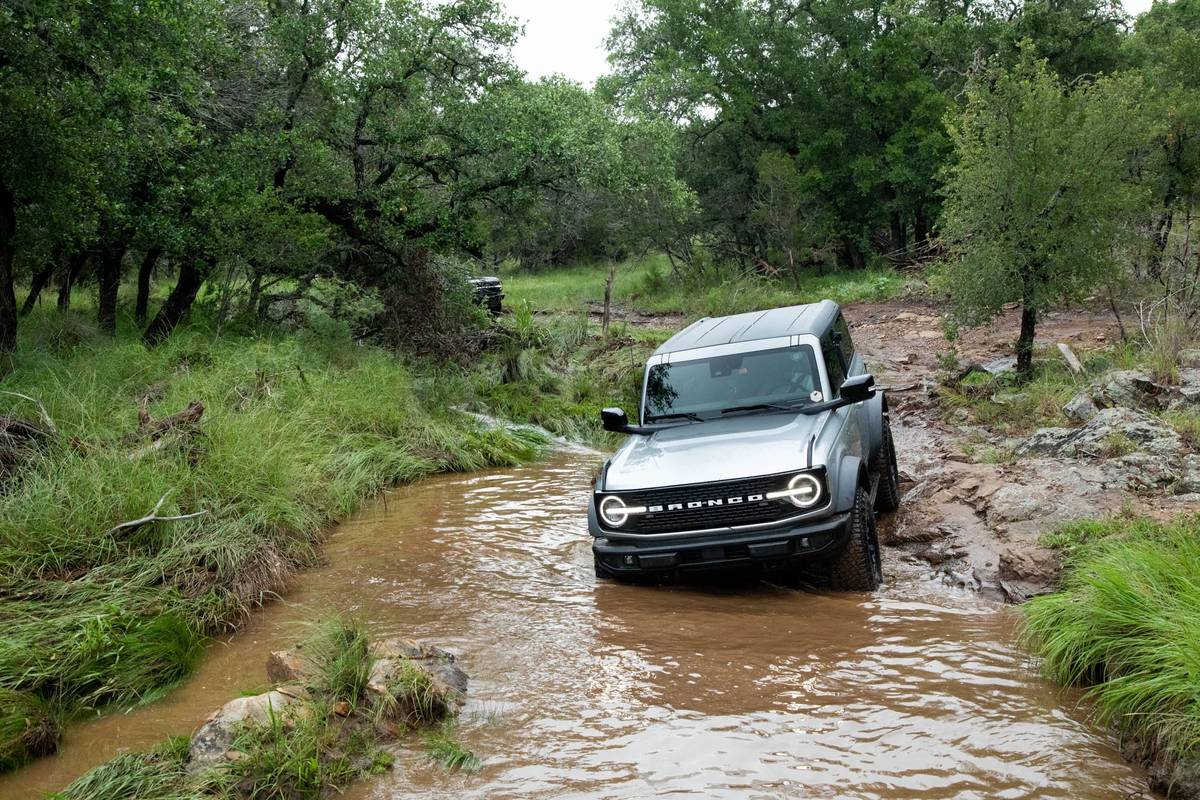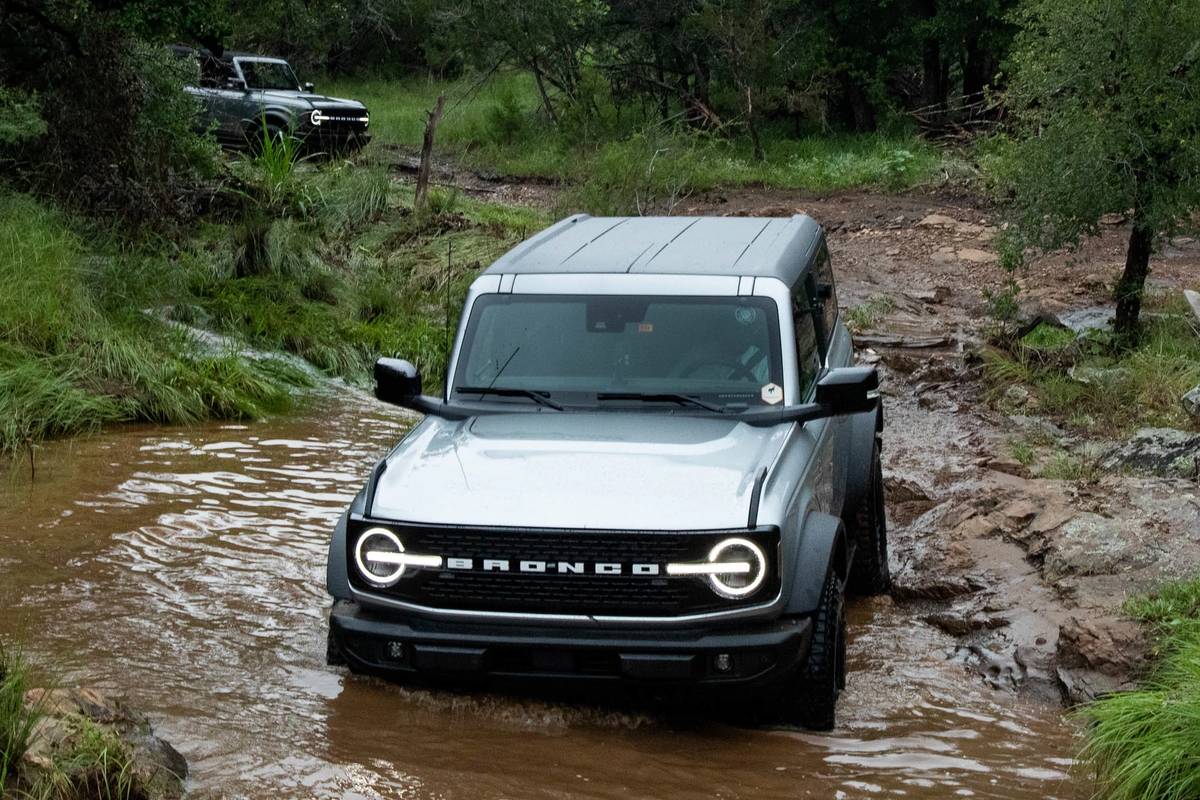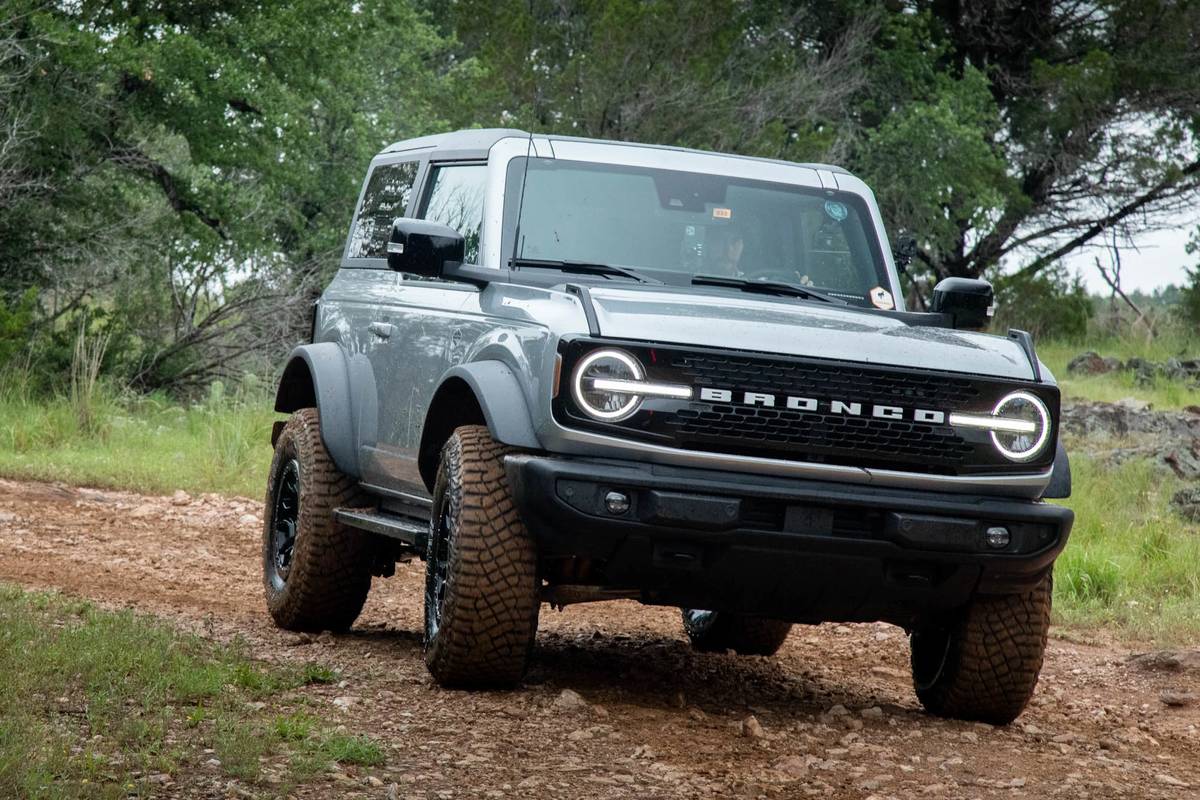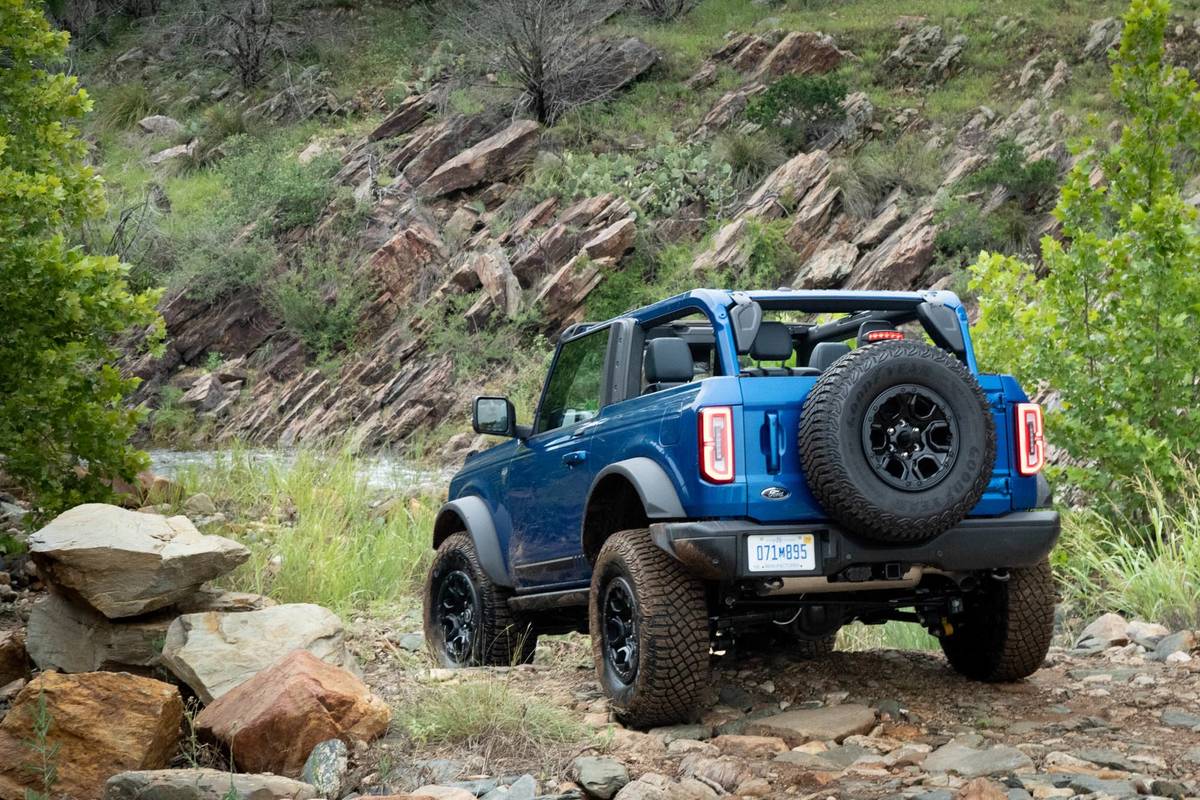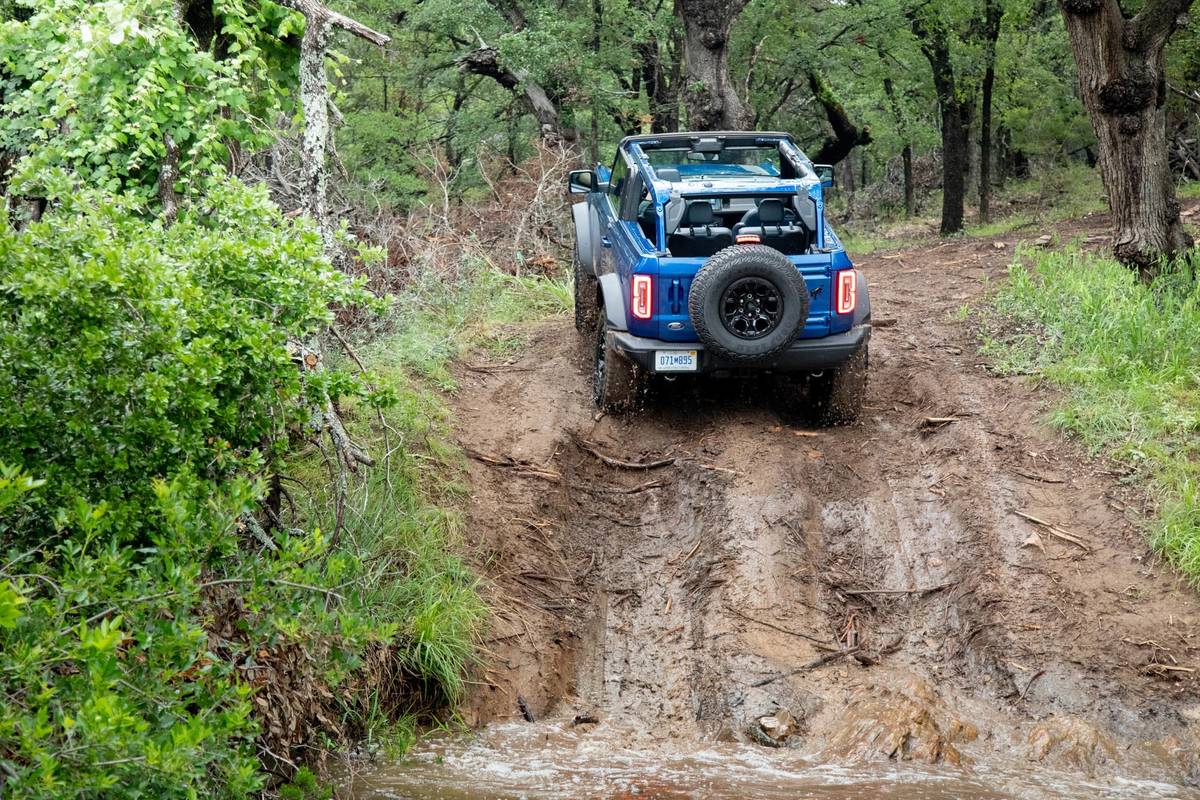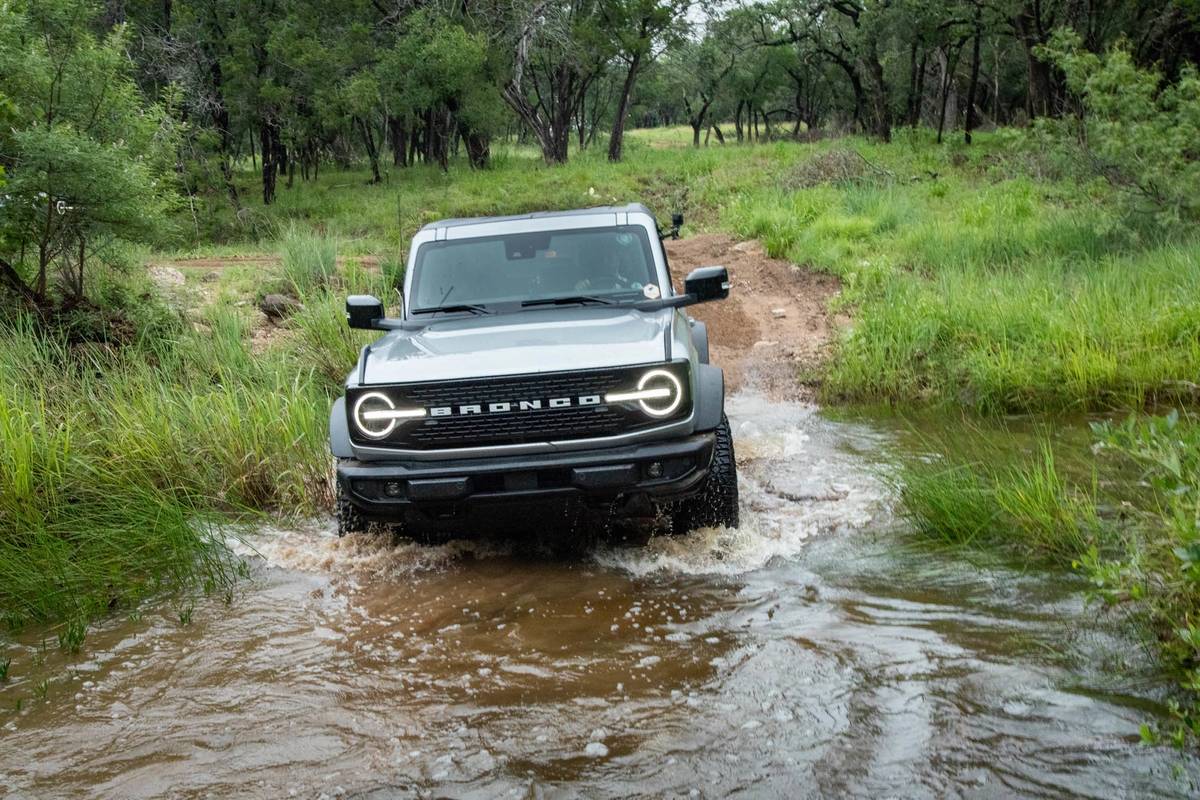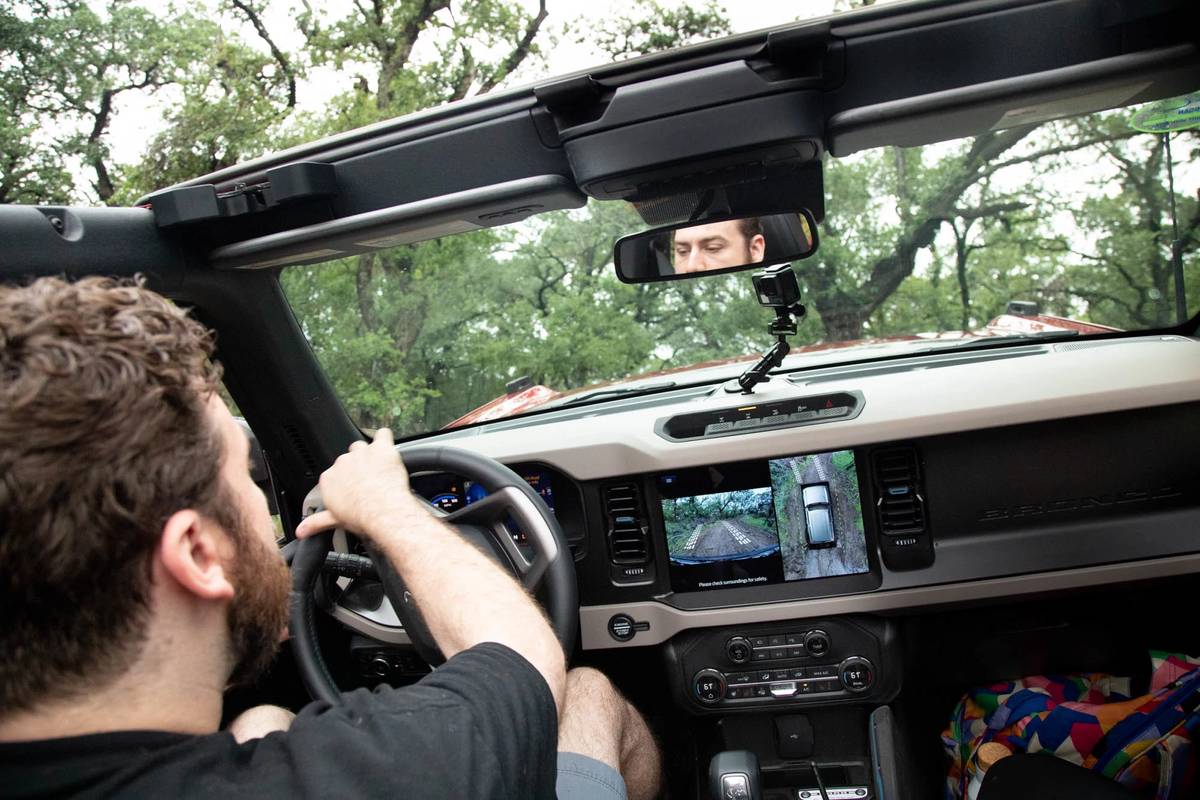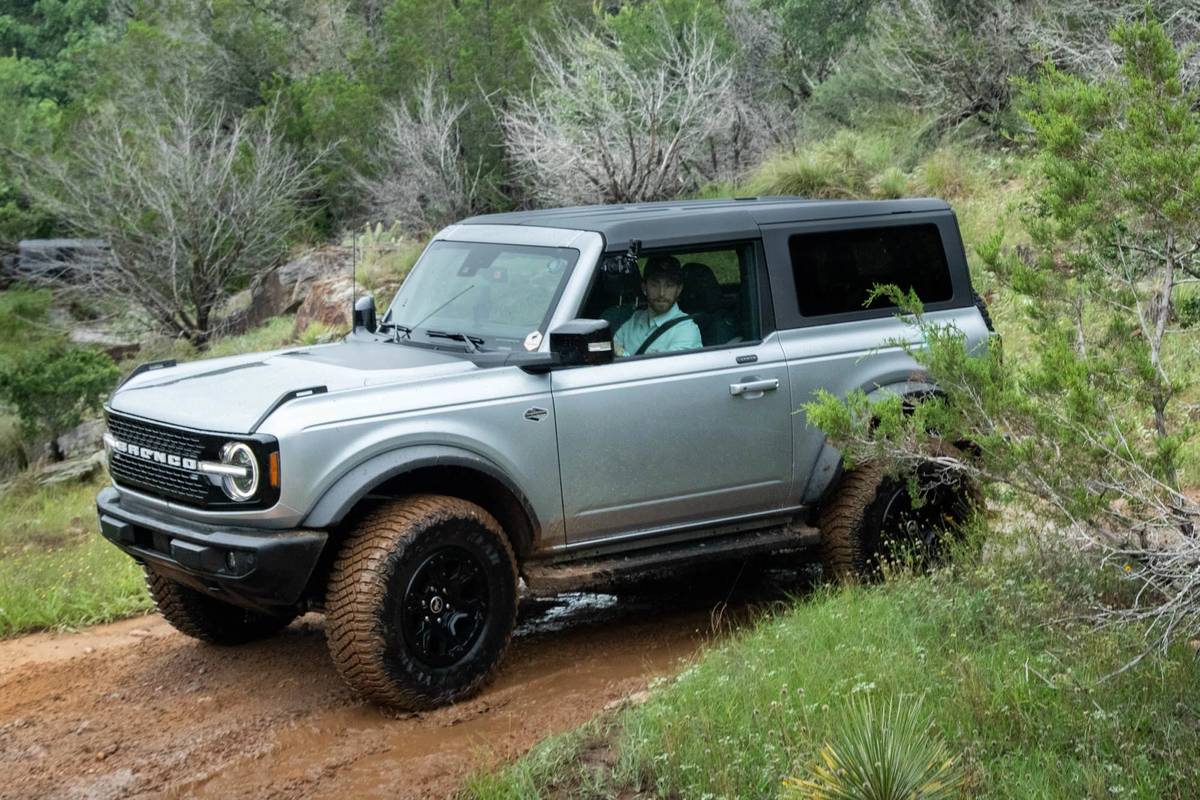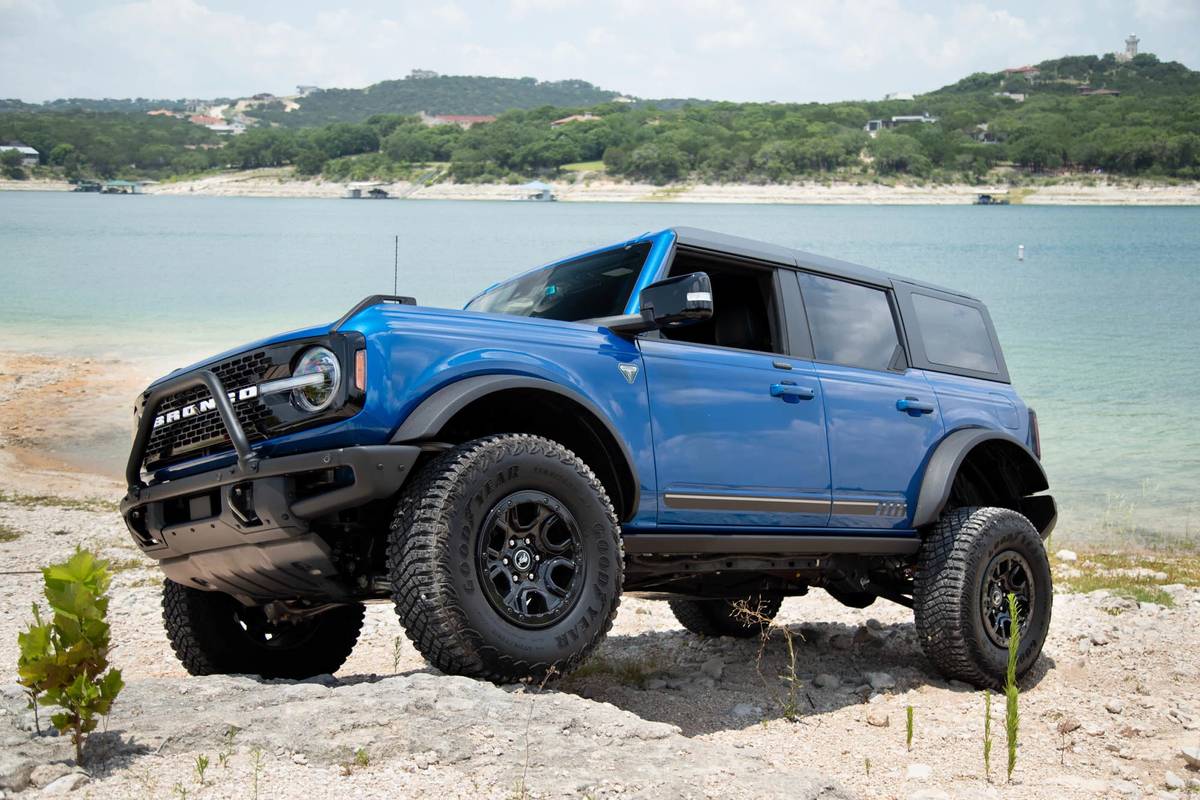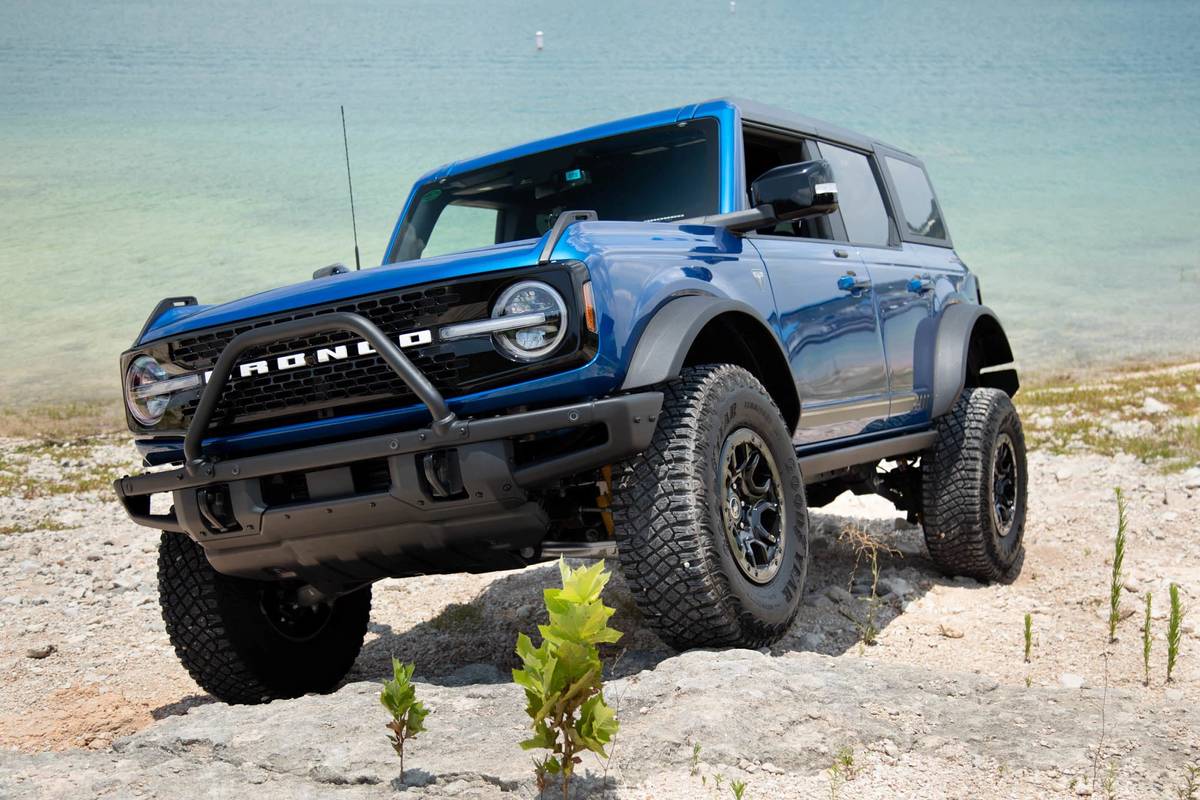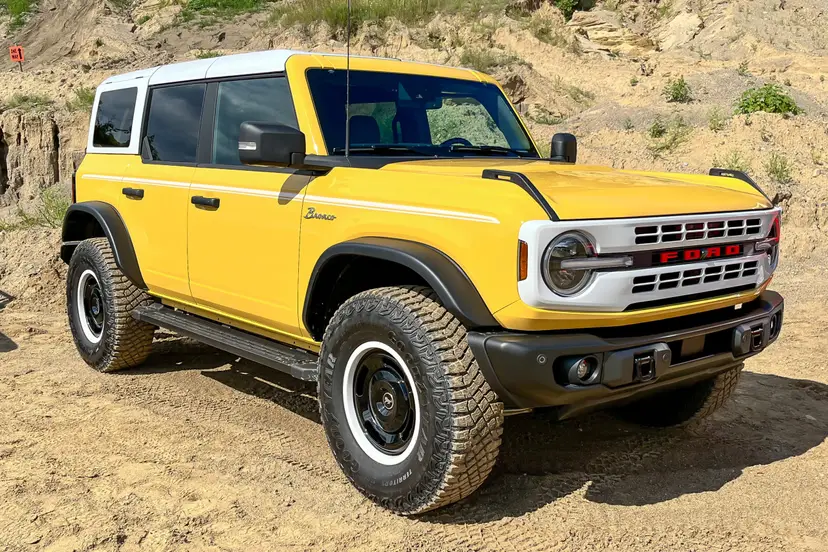
The verdict: With solid on-road manners and tons of off-road capability straight from the factory, the Ford Bronco should be among the top choices of any shopper looking for a vehicle to take them off the beaten path.
Versus the competition: The only area where the Bronco might lack compared with its competitors is in built-up brand equity and positive name recognition, given that the previous Bronco was last sold in 1996.
The 2021 Ford Bronco is one of the most hotly anticipated vehicles in recent memory, and pandemic-related delays have only made the waiting worse. (The earlier launch of the Bronco Sport, a smaller vehicle on a separate, unibody platform, has probably made confusion worse.) But the proper body-on-frame Bronco is finally rolling off assembly lines, and I traveled to the Texas Hill Country to drive it both on- and off-road, including at the first Bronco Off-Roadeo about an hour outside of Austin. (Per our ethics policy, Cars.com pays for its own airfare and lodging at such automaker-sponsored events.)
Related: 2021 Ford Bronco and Bronco Sport First Impressions: More Capable Than Expected?
The 2021 Ford Bronco has two very small and simple aims: first, to live up to the iconic Bronco name (the part that isn’t associated with police chases) and, second, to challenge the Jeep Wrangler’s position atop the heap of off-roading SUVs. You know, little goals.
The Bronco is available in seven trim levels, and like the Wrangler, each trim has varying levels of off-roading intent:
- Base
- Big Bend
- Black Diamond
- Outer Banks
- Wildtrak
- Badlands
- First Edition
Unlike the Wrangler, however, Ford has made the optional Sasquatch Package — adding 35-inch mud-terrain tires, an off-road suspension and more — available on all trim levels. The Wrangler limits all the really good stuff to the Rubicon trim.
New Old Looks
The Bronco looks big and bulky in person (in a good way), and its aggressive styling, particularly on Sasquatch-equipped models, hints at its abilities. Retro details like its grille design and round headlights are a nod to the iconic first-generation Bronco, as is the availability of a two-door model. In a Bronco first, however, the new model can also be had as a family-friendlier four-door.
The new Bronco is longer and wider than the current Wrangler, and can be shorter or taller depending on trim level and equipment. The doors and roof are removable, revealing thick roof pillars that hold standard side-curtain airbags. The doors are cleverly designed for easy removal by a single person, as are the roof panels, but the rear portion of the roof is best done as a two-person job. Ford has storage bags for the removable parts, and instructions for removal are accessible via the digital owner’s manual in the center display or online. There’s a QR code on the bags that took me to Ford’s YouTube page, where I could search for an instructional video there, as well.
While the doors are removable, the Bronco’s side mirrors are not attached to the doors. The design gives the Bronco a bit of a Snidely Whiplash or pretentious barista handlebar mustache, but it also means that if you want to drive around with the doors off, you aren’t put in the same spot as Wrangler owners: either not having side mirrors at all or purchasing aftermarket replacements. Also, if you take the doors off in a four-door Bronco, you can bag them up and take them with you.
Highly Functional Interior
The Bronco’s interior layout keeps important controls within easy reach, and those controls are mostly well laid out, clearly labeled and intuitive. The central touchscreen — measuring either 8 or 12 inches, depending on trim level and equipment — uses Sync 4, quickly becoming one of my favorite non-luxury operating systems for its clear graphics and ease of operation. Above the screen are what Ford calls “hero switches,” controls for off-road functions like the available stability bar disconnect, locking front differential, locking rear differential, Trail Turn Assist, traction control and the hazard lights. These rubberized buttons remain within easy reach even when the Bronco is precariously perched on an obstacle, and the labeling makes it easy to find and select your desired function. The only controls I wasn’t really a fan of while driving were the window and side mirror controls, which are positioned behind the gear and drive mode selector, but that’s the price one pays for having removable doors.
Seats can be upholstered in cloth, leather or my personal favorite, marine-grade vinyl that’s mold- and mildew-resistant. The seats themselves are firm, an ongoing issue I’ve had with Ford seats, but the interior feels less cramped than a Wrangler. (And of course it feels downright airy with the doors and roof off.) The vinyl seats are standard on the Black Diamond and Badlands, and are part of a fully washable interior with integrated floor drain plugs. Also present in the Bronco are very sturdy-feeling grab handles for easier entry and for holding onto during rougher portions of a drive. Like the window and mirror controls, the handles aren’t mounted on the doors or roof as they are in most vehicles. One other minor complaint, and this might just be the Texas heat talking, is the lack of ventilated seats as an option.
The last important interior bit is the selector for the various drive modes, or as Ford calls them, the G.O.A.T. — Goes Over Any Type of Terrain — modes. It also houses the buttons to select two-wheel drive, 4WD High, 4WD Low and 4-Auto, and in its center, the button to activate Trail One-Pedal Drive. We’ll address how those modes work below. The selector itself, however, has a solid feel and, like the hero switches, is easy to use.
Well Mannered on Pavement
My on-road driving time was limited to a single vehicle, and the one I chose was a Badlands trim level. Its twin-turbocharged 2.7-liter EcoBoost V-6 makes 330 horsepower and 415 pounds-feet of torque when using premium gas (those numbers drop by 15 hp and 5 pounds-feet, respectively, with regular gas), and it’s coupled with a 10-speed automatic transmission. The powertrain provides ample power on-road, and I didn’t notice any of the issues we’ve had with other Ford 10-speeds during my driving time. Buyers can also choose a turbo 2.3-liter four-cylinder engine with 300 hp and 325 pounds-feet of torque on premium gas (275 and 315, respectively, on regular). The four-cylinder can be paired with either a seven-speed manual transmission with a dedicated creeper gear or the 10-speed auto.
The Bronco Badlands with the Sasquatch Package, despite its 35-inch off-road tires and off-road suspension, was well mannered and maneuverable on the pavement. There was minimal tire noise, too, which was surprising, and road and wind noise levels were also better than I expected considering the removable roof and doors; even at 55 mph or more with the roof off, conditions were fairly quiet.
On the other hand, the on-road experience also felt sterile and detached. Maybe I’m too used to off-road SUVs feeling clumsy outside of their natural environment, but the steering seems optimized for off-road use and felt uncommunicative at higher speeds, and the brakes worked well but lacked linearity or solid pedal feel. The on-road driving experience was still much better than any I’ve had in any number of Wranglers, however.
Nimble as a Goat Off-Road
My off-roading in the Bronco consisted of three different trails of increasing difficulty, but the Bronco handled everything we threw at it. In fact, the most impressive bit was actually when a Bronco in our convoy lost all of its various electronic off-road aids mid-trail and had to scale a rock face with nothing but low-range 4WD. It took a lot more effort for it to get over the obstacle, but it did it.
That’s because even without all the bits that make off-roading easy, the Bronco is a serious machine. With a solid Dana 44 rear axle and Dana AdvanTek front axle, lower trim levels get two-speed electronic shift-on-the-fly 4WD, while higher-end trims get an electromechanical transfer case that adds 4-Auto. Spicer Performa-Trak electronic locking front and rear differentials are available. The underbody of the Bronco has loads of protective plating, and side rock rails capable of supporting the weight of each side of the vehicle are also available. Plus, buyers can add a modular steel bumper that can add an integrated winch.
Without the Sasquatch Package, the Bronco has approach, departure and breakover angles of 35.5, 29.8 and 21.1 degrees, respectively, as a two-door, and 35.5, 29.7 and 20.0 as a four-door. Going Sasquatch changes those to either 43.2, 37.2 and 29.0 degrees for the two-door or 43.2, 37.0 and 26.3 for the four-door. Ground clearance is 8.4 inches in the base two-door and 8.3 in the base four-door, increasing to 11.6 or 11.5, respectively, with the Sasquatch Package.
The throttle is mostly very easy to modulate during low-speed off-roading. Ford includes a Trail One-Pedal Driving feature that applies braking force when the driver lets off the accelerator pedal. I found it difficult with that feature engaged not to overapply the throttle at least occasionally, which made clearing obstacles a bit more herky-jerky, but I’m sure with more time a driver could strike the right balance.
Trail Control operates like cruise control for off-roading and handles all the accelerator and brake inputs. Again, I preferred not to use it, mostly because I don’t like ceding that much control to the machine. If you’re comfortable with that, however, it works well, particularly at slowing descents.
My favorite Bronco party trick is Trail Turn Assist, which works during a turn at speeds up to 12 mph and, once activated, engages when the steering wheel is at full lock (turned all the way in either direction). It applies braking forces to the inside rear wheel and turns it into a fulcrum, allowing for much sharper turns and reducing the need for reversing and multipoint turns to continue along the trail.
The Bronco also offers a variety of G.O.A.T. driving modes depending on trim level and equipment. There are eight all told, seven for a single SUV: Normal, Eco and Sport for on-road driving; and Slippery, Sand, Mud/Ruts, Rock Crawl and Baja for off-roading (Sport gets replaced by Rock Crawl on Badlands and First Edition trims). Select one and the vehicle will make necessary switches to the two- or four-wheel-drive setting and possibly engage a differential lock, as well.
The multiple camera systems are also a boon for off-roading, and while I always prefer having a spotter, they can at least partially make up for a lack of one in certain sections. The forward camera is smartly positioned so that you can see what’s ahead of the vehicle as you’re cresting a blind ridge and enables you to properly align your tires for obstacles that are part of the descent. There are additional views available, as well, including a split view with the front camera and an overhead view with dynamic tire lines, and a side-by-side view of the two front tires so you can see exactly what you’re driving over. Also helpful for off-roading are the brackets mounted at the front corners of the Bronco’s fenders. They’re great for helping to aim the Bronco (even in on-road driving) and also double as tie-down points for roof-mounted loads.
After sampling a variety of Bronco flavors off-road, my preference for serious off-roading is a two-door model with the Sasquatch Package. Because of its smaller size and shorter wheelbase, the two-door Bronco felt the most nimble.
None of the obstacles we faced in the Bronco were things a Wrangler couldn’t also do, but that’s kind of the point, isn’t it? The Wrangler is the gold-standard off-roader and, when properly equipped, can take on practically anything. Based on what I’ve seen, a Bronco shouldn’t have any problem keeping up.
More From Cars.com:
- What’s New for Ford in 2021?
- What’s New With SUVs for 2021?
- Ford Moves Back 2021 Bronco Deliveries to Summer
- Ford Listens to Demand, Will Pair Manual Transmission With Bronco Sasquatch Package
- Ford Sync 4 Multimedia System Can Find You a Parking Spot, Cheap Gas
Safety
Another area where Ford looked at the Wrangler and saw a chance to differentiate the Bronco is safety. You may have noticed that, with the roof off, the Bronco’s roof support structure is quite substantial. That’s because along the sides are standard side curtain airbags. As a convertible, the Bronco is technically exempt from the federal safety standard requiring side curtain airbags, but Ford decided the Bronco should have them anyway. The Wrangler does not. Ford also says the Bronco meets a side impact crush standard from which it would also be exempt. Ford even crash-tested the Bronco with its available winch accessory to ensure that adding it didn’t pose a threat to occupants in a crash.
What that does for the Bronco’s safety ratings, however, is unclear. As of this writing, the Bronco hasn’t yet been tested by either the Insurance Institute for Highway Safety or the National Highway Traffic Safety Administration.
Is the Bronco Better Than the Wrangler?
On pavement, the Bronco is absolutely the better vehicle. The ride and handling are better and more pleasant. Off-road is a different story and much harder to quantify, but I suspect a Bronco-versus-Wrangler off-road battle would end up like the old McDonald’s commercial where Michael Jordan and Larry Bird played horse.
Where the Jeep currently has the advantage is in powertrain choice, with the Rubicon 392 performance model, the 4xe plug-in hybrid and EcoDiesel — all options the Bronco can’t currently match. Ford wouldn’t say what the future holds for the Bronco, but with its continued push toward electrification, it seems likely a hybrid or PowerBoost plug-in hybrid could happen.
I think the Wrangler also has better name recognition at the moment, along with decades of extra brand loyalty and community baked into the ownership experience. Ford is looking to challenge that, including via an Off-Roadeo experience included in every Bronco purchase. If you buy a Bronco and can get yourself to one of the locations across the country, Ford will have experienced trail guides help you learn how to get the most out of your Bronco. Even better: The experience won’t be in your Bronco, eliminating some of the inherent fear of damaging a personal vehicle that understandably prevents owners from always getting the most out of their off-roaders.
With a better, if slightly detached, on-road feel and factory off-road capabilities that would rival a goat’s, the Bronco will certainly give the Wrangler a run for its money. Ford appears all in on the Bronco, and if buyers and shoppers show the same sort of enthusiasm, the Bronco has a chance to make up ground on the Wrangler’s cultural status, too. Will the Bronco ever unseat the Wrangler? I can’t say. But I wouldn’t bet against it.
Editor’s note: This story was updated June 30, 2021, to reflect that the Sasquatch Package is available on all trims but not standard on any.
Related Video: 2021 Ford Bronco: First Drive
We cannot generate a video preview.
Cars.com’s Editorial department is your source for automotive news and reviews. In line with Cars.com’s long-standing ethics policy, editors and reviewers don’t accept gifts or free trips from automakers. The Editorial department is independent of Cars.com’s advertising, sales and sponsored content departments.



































